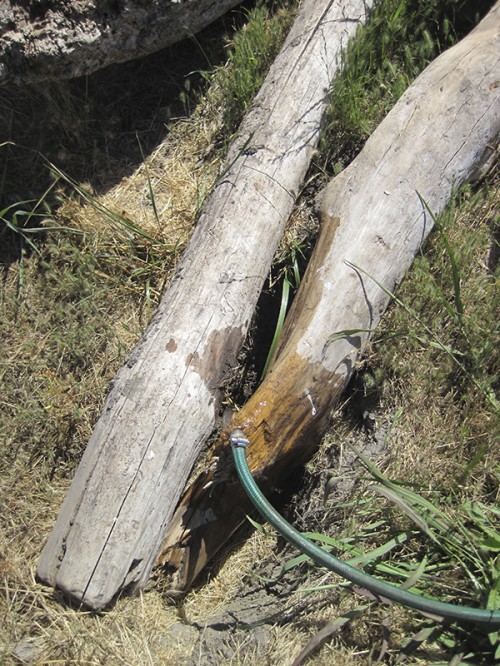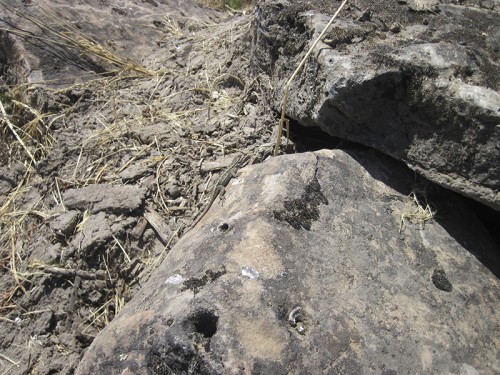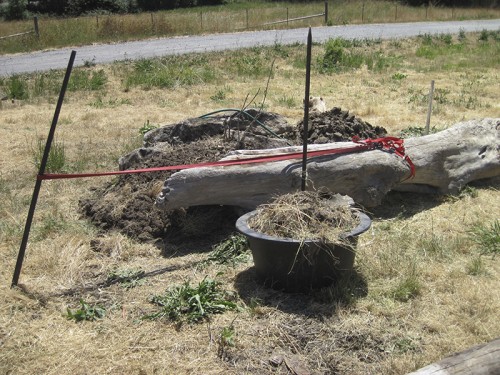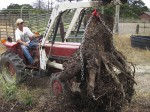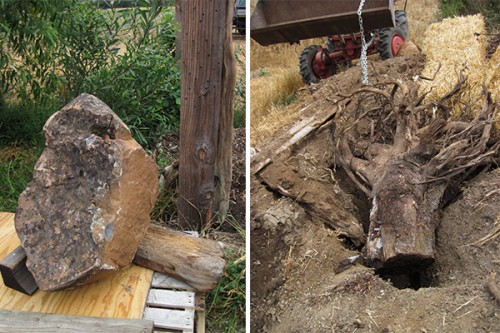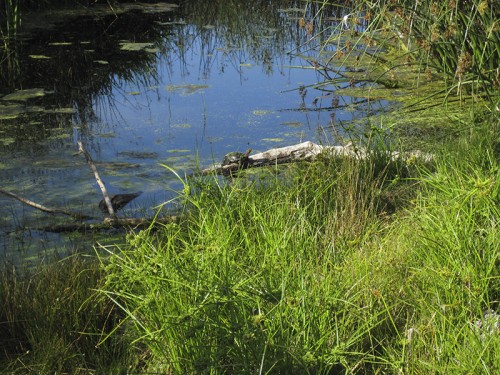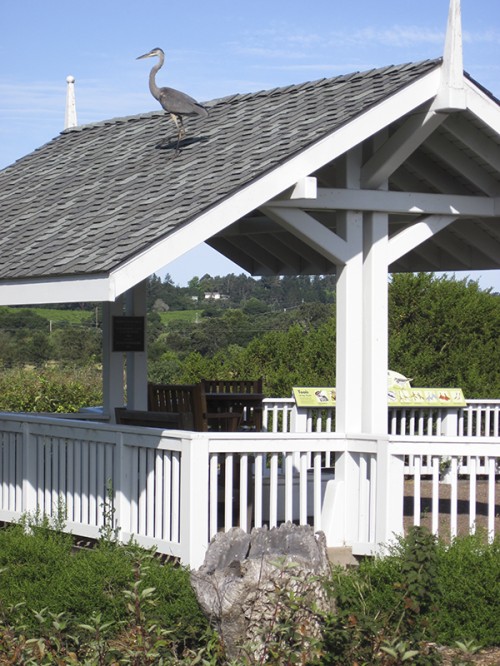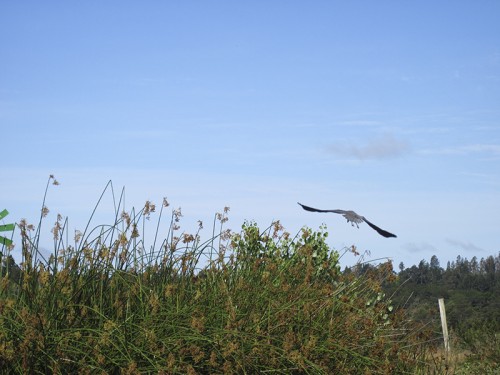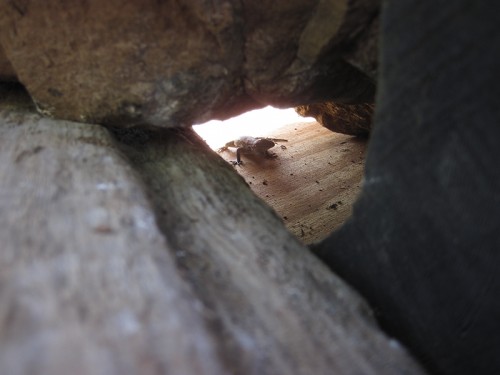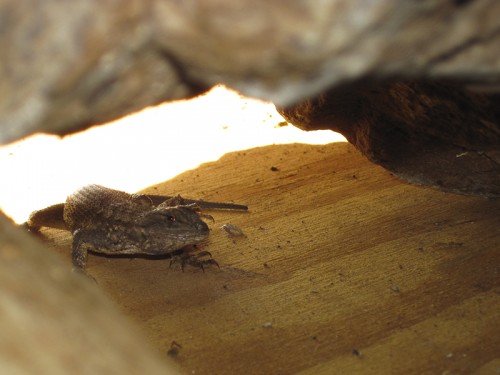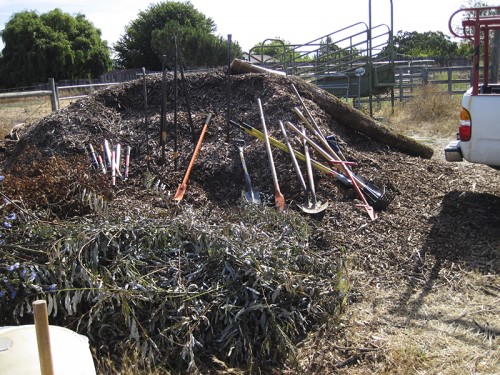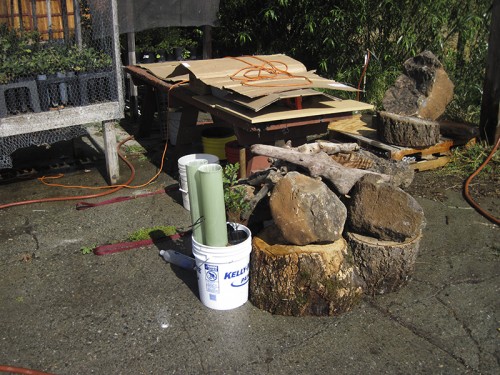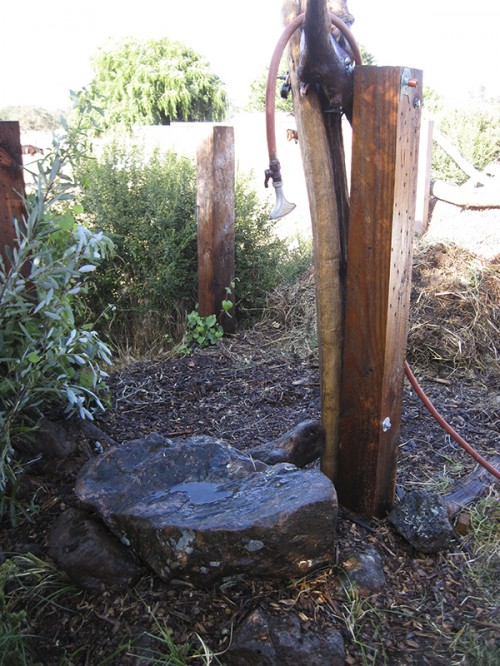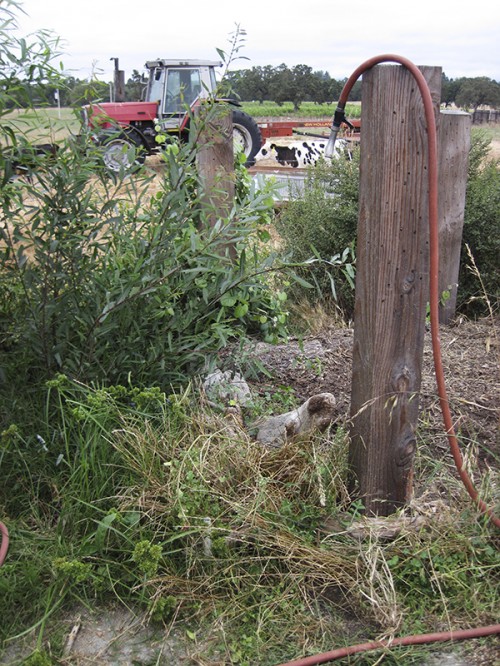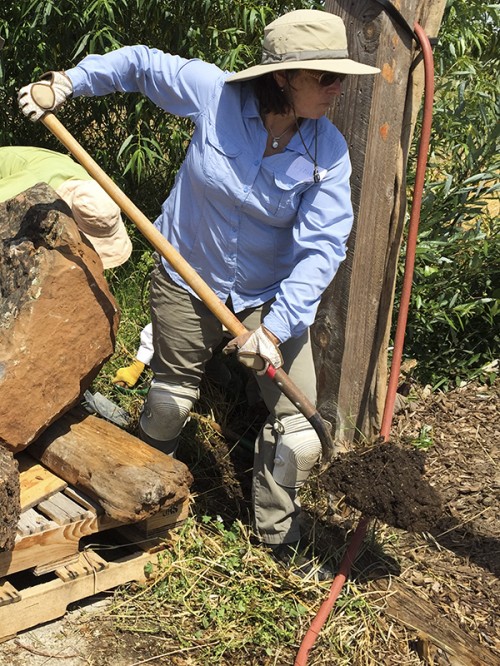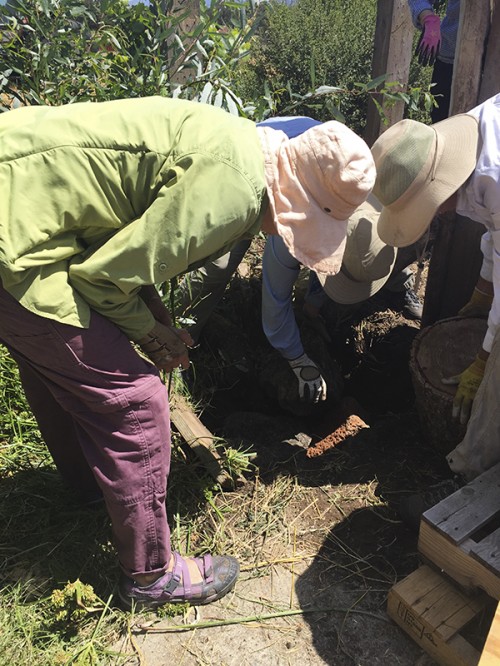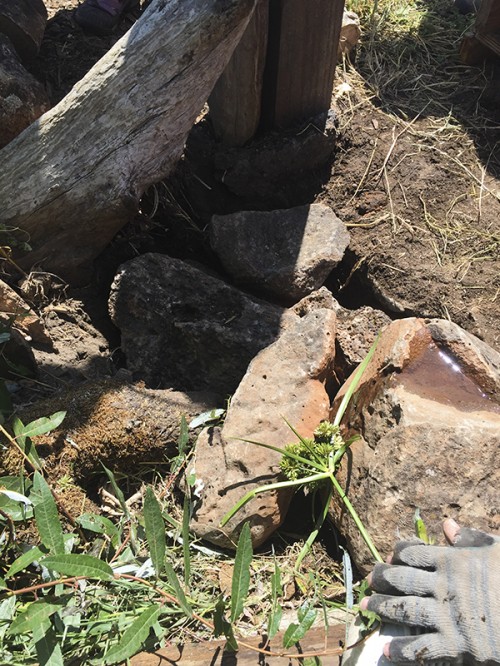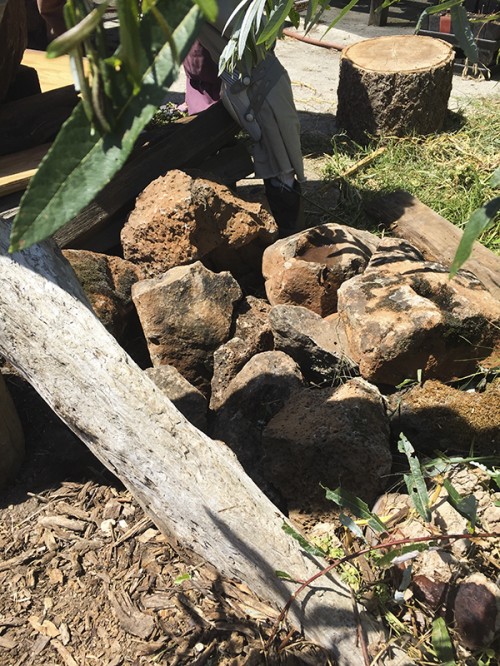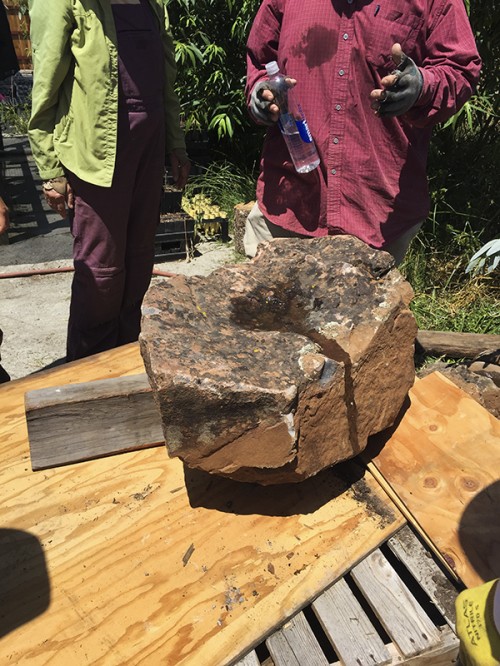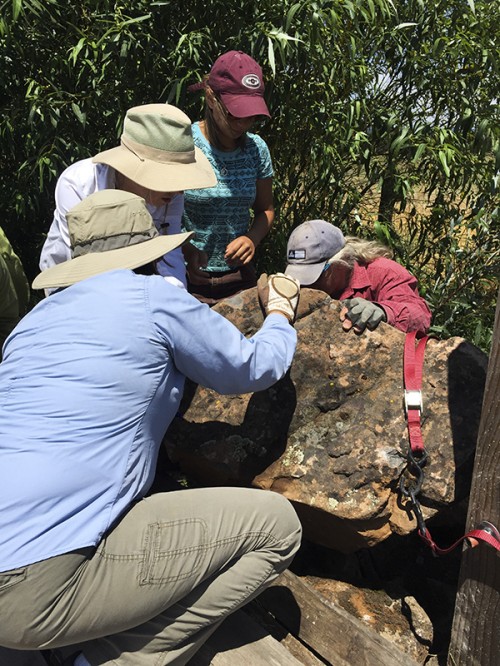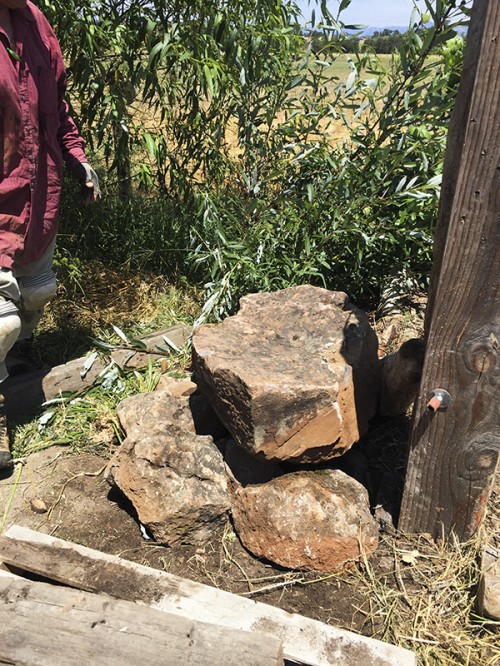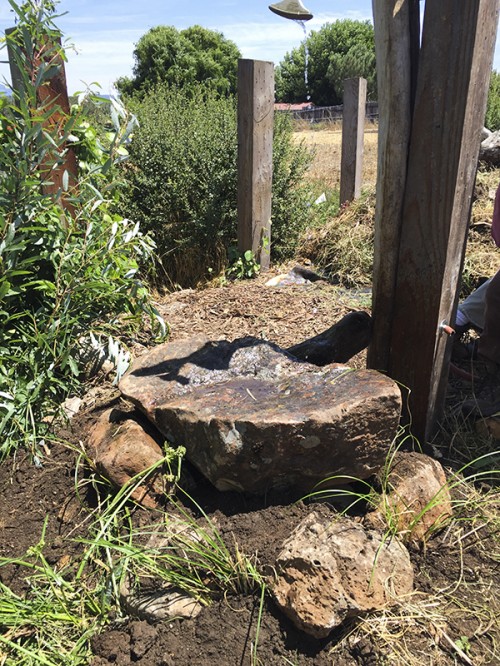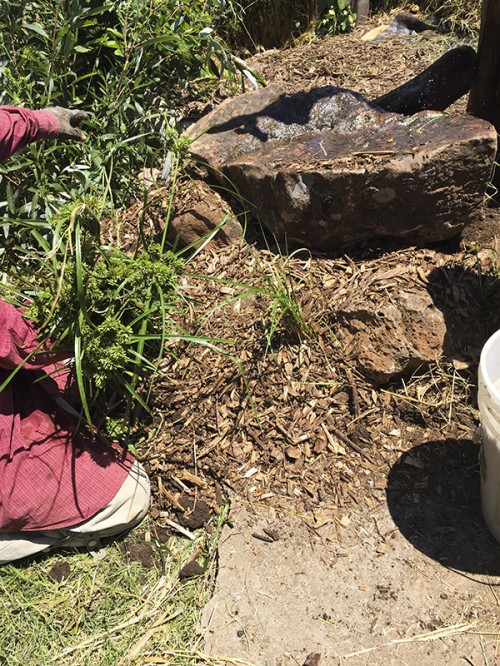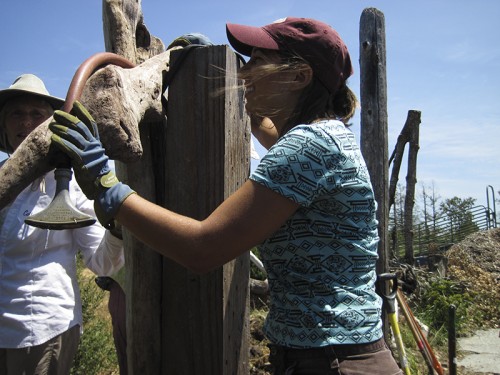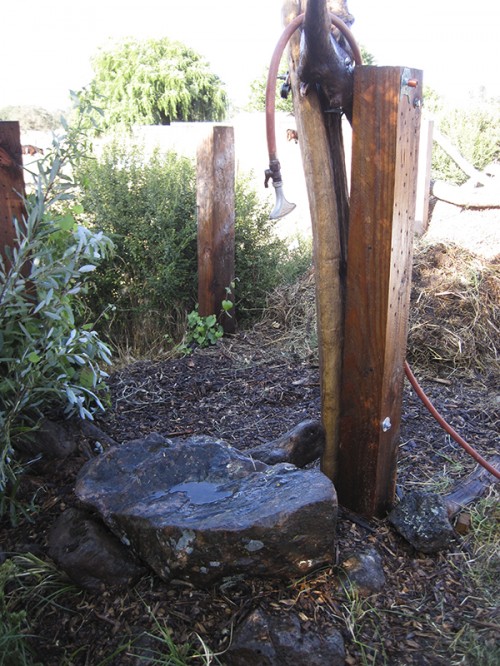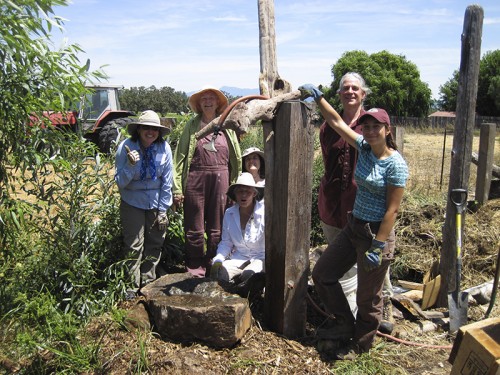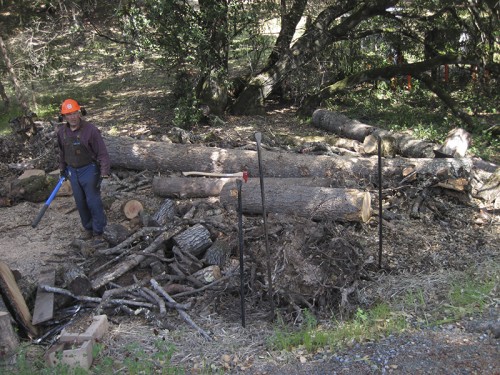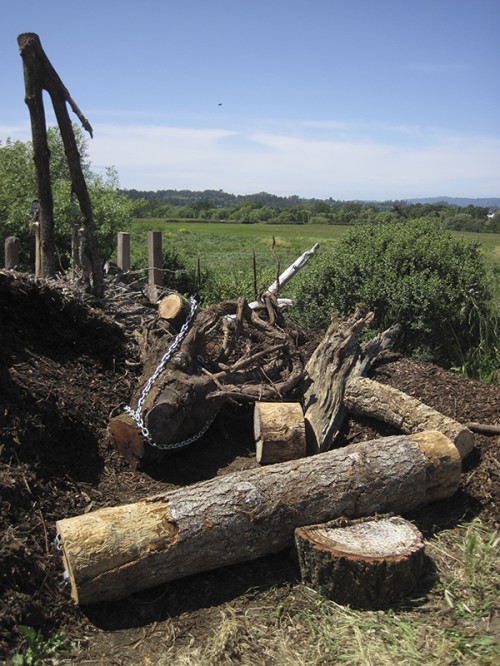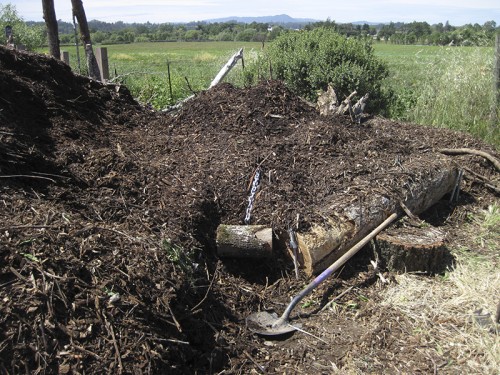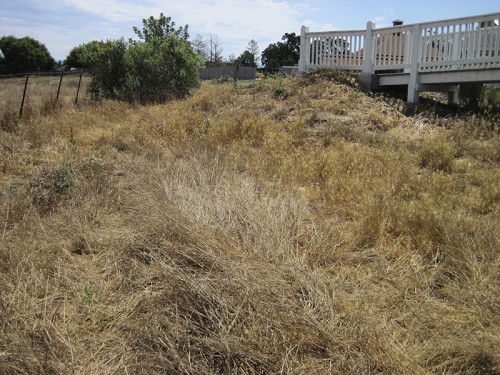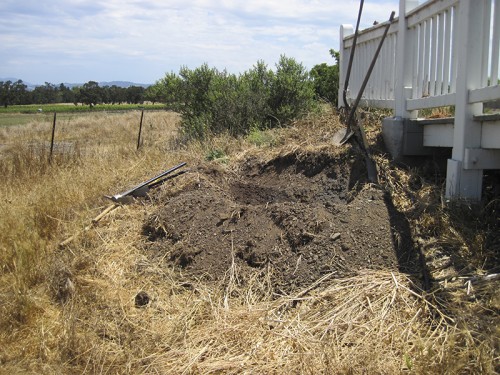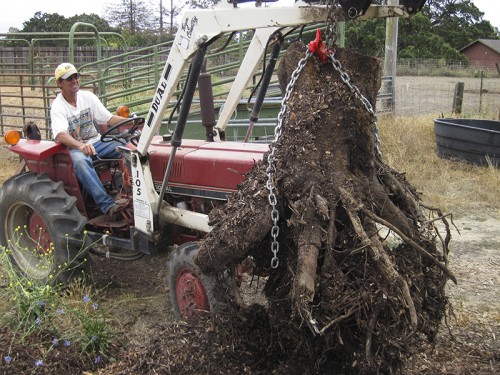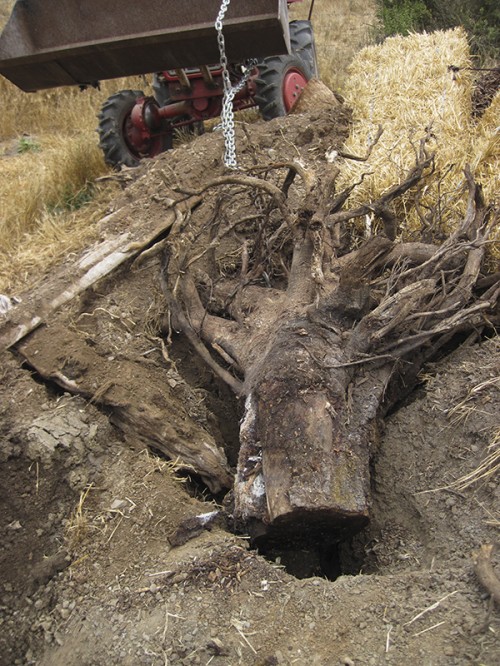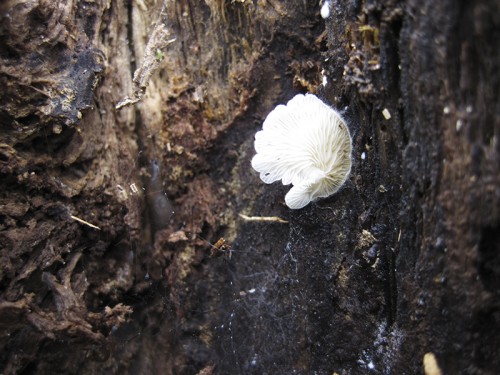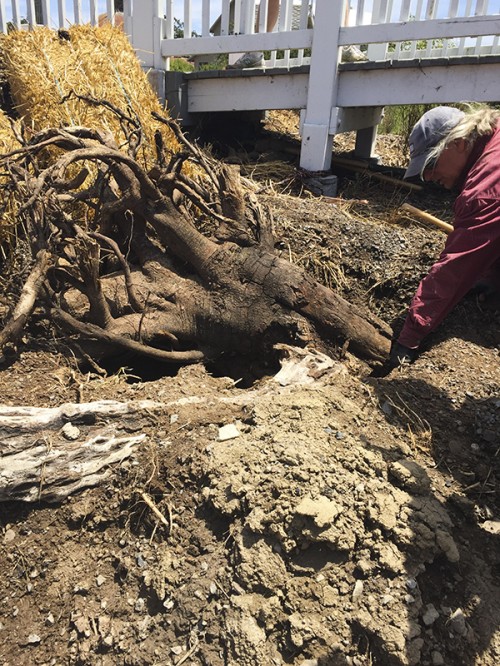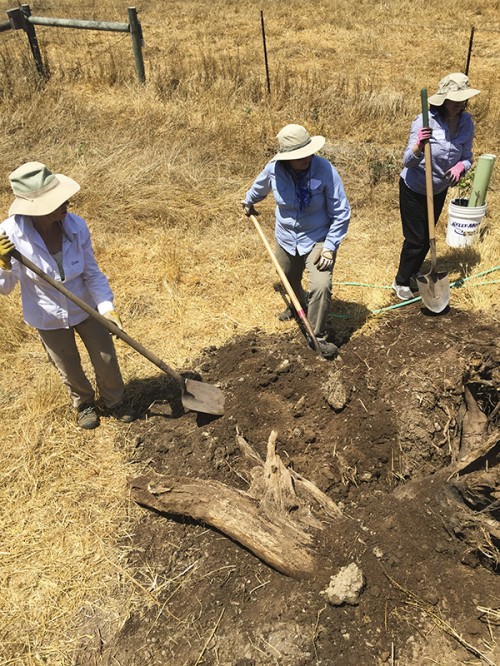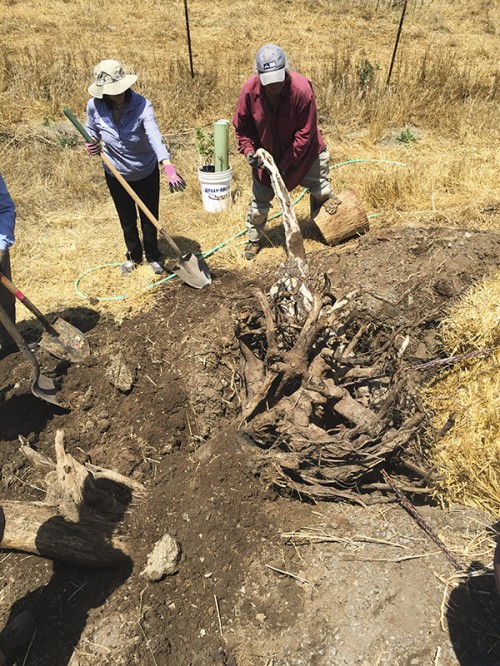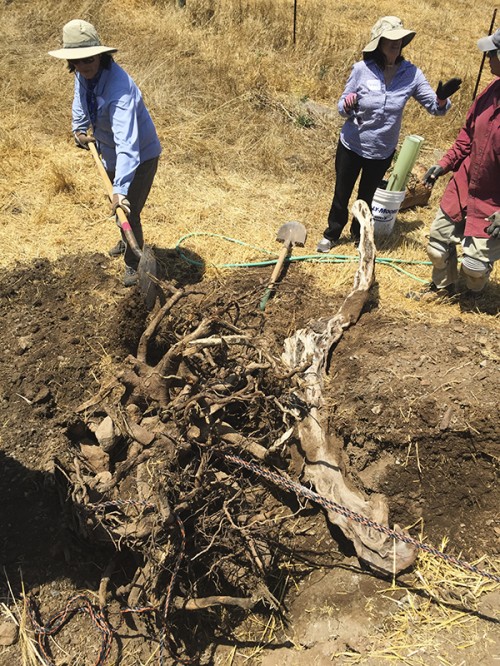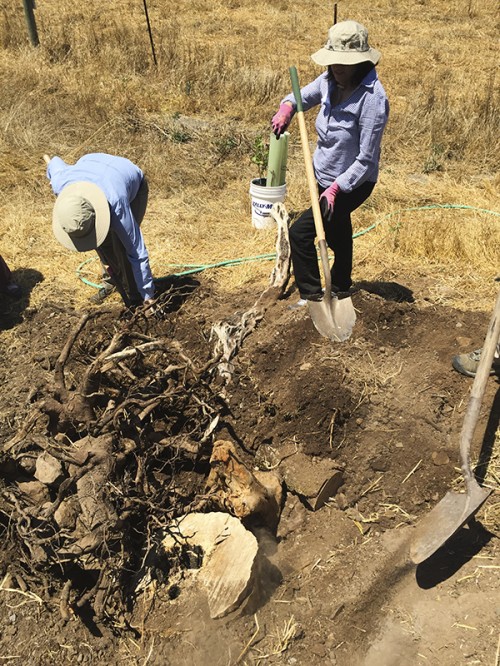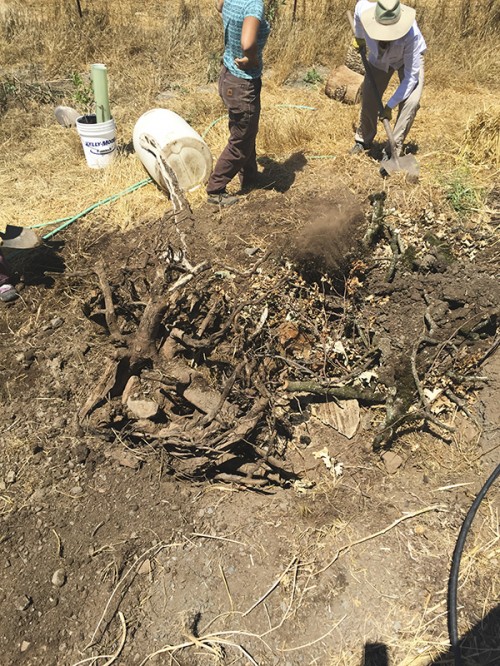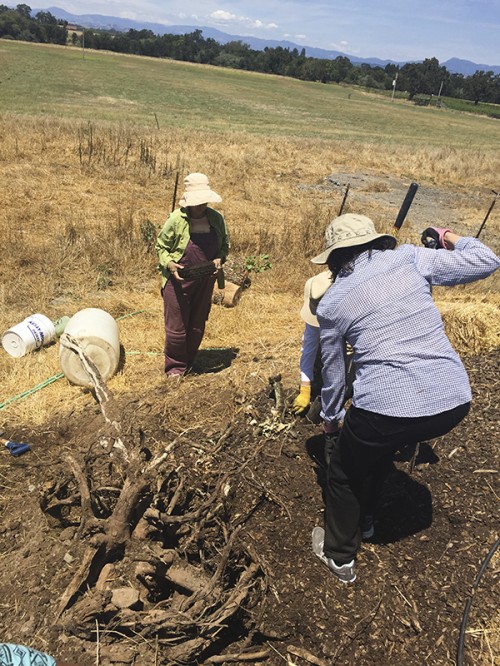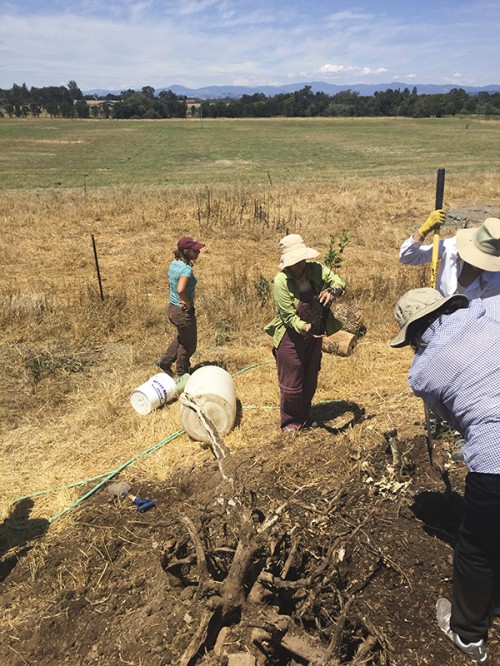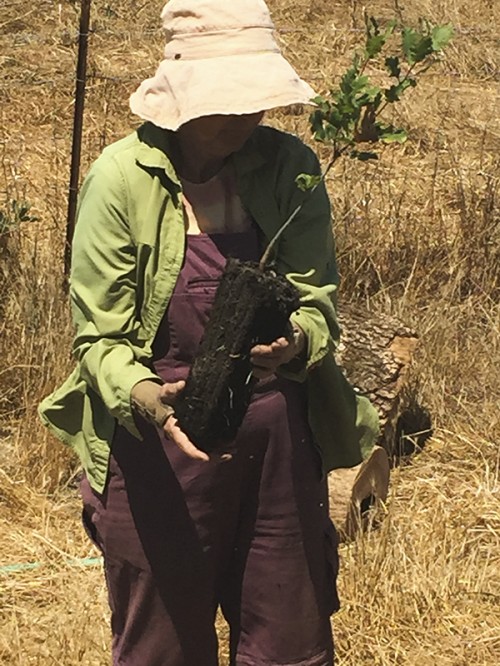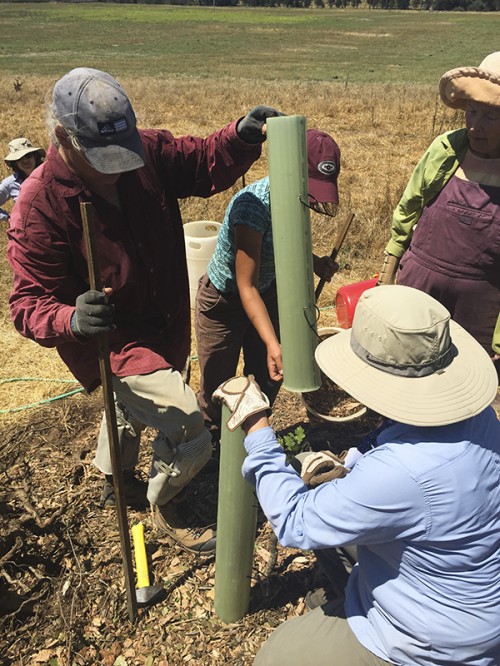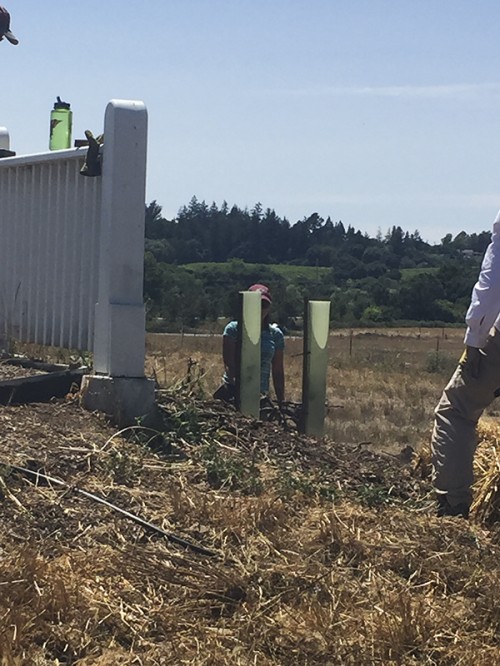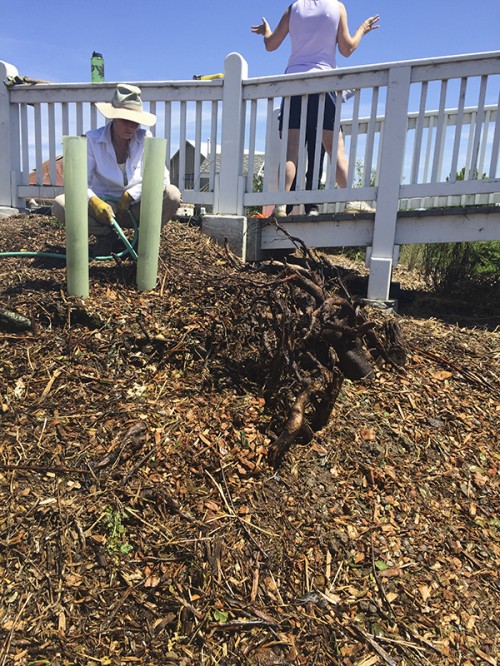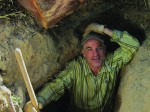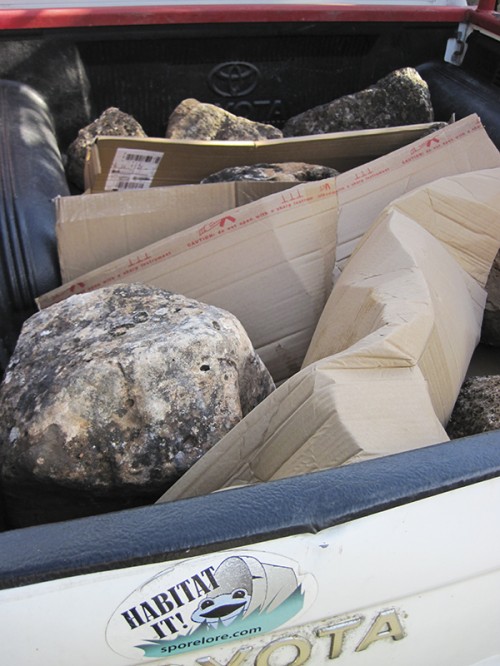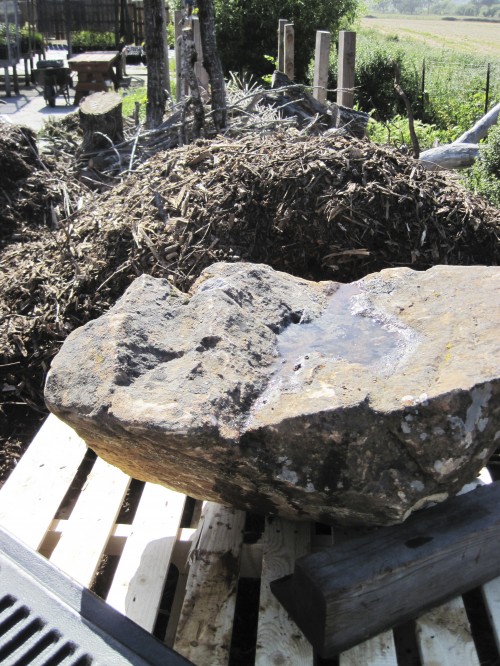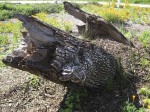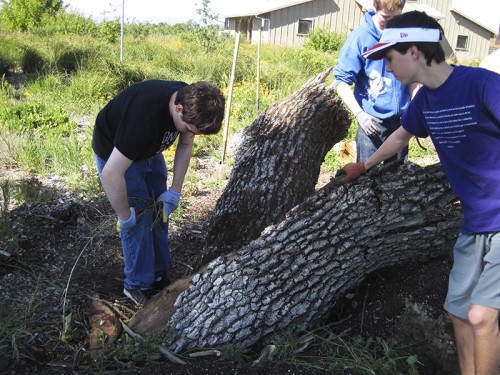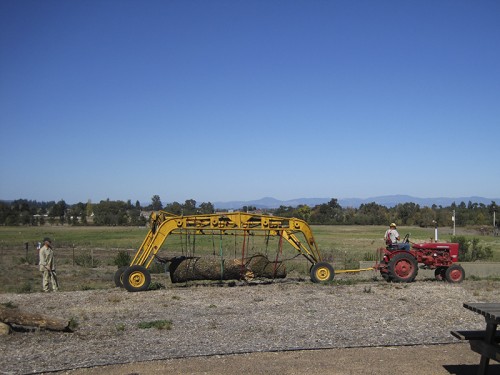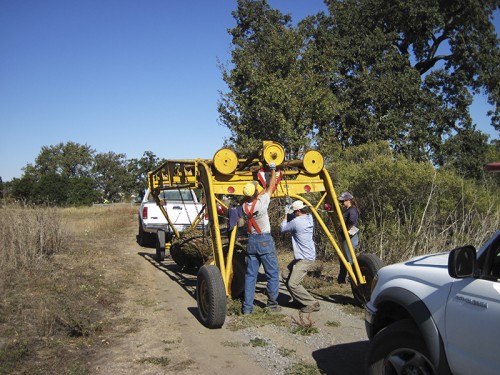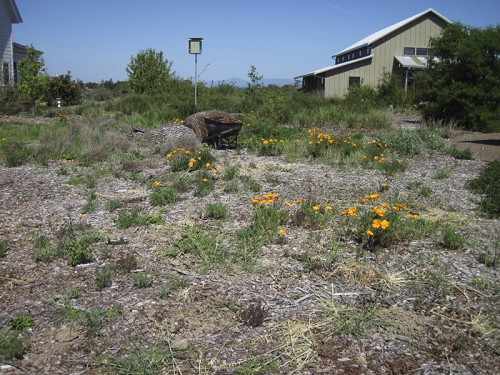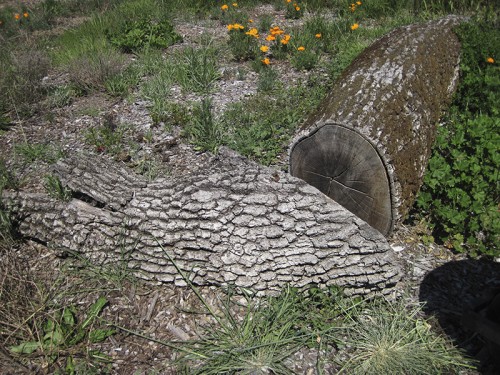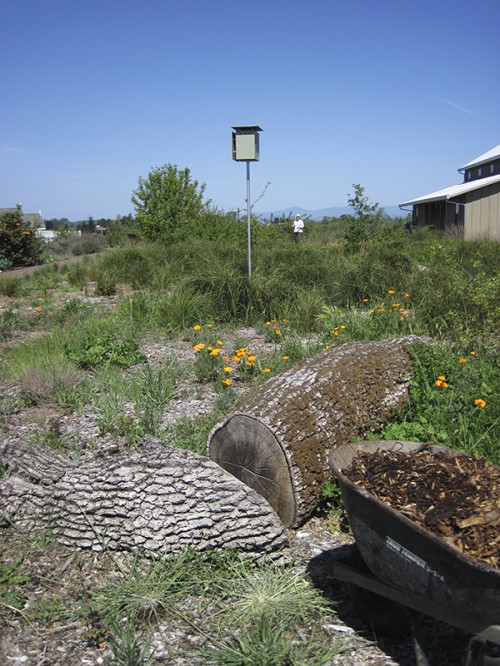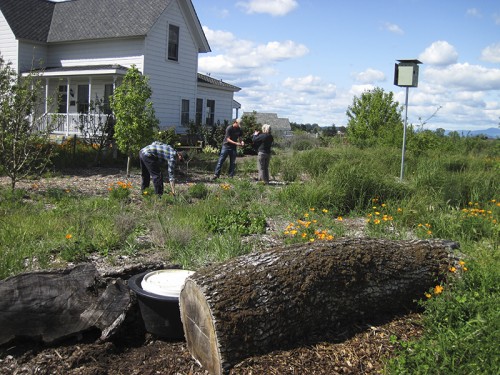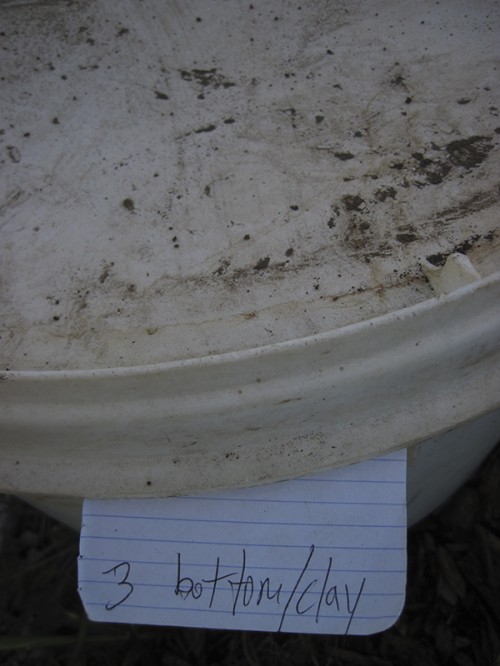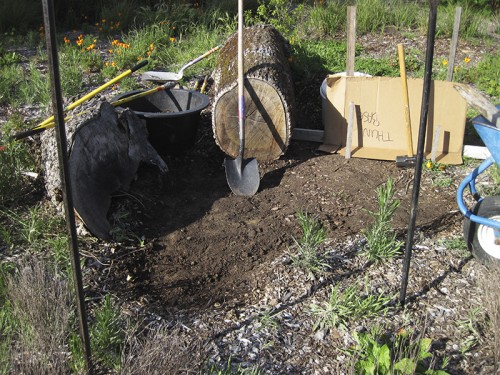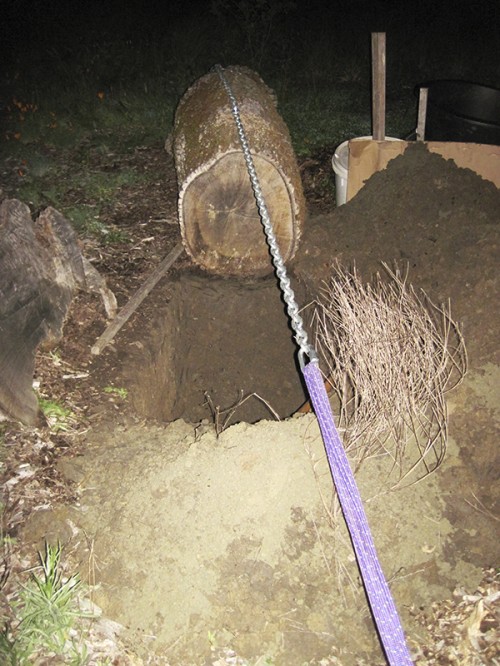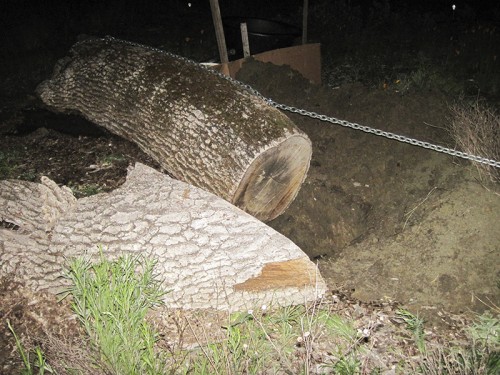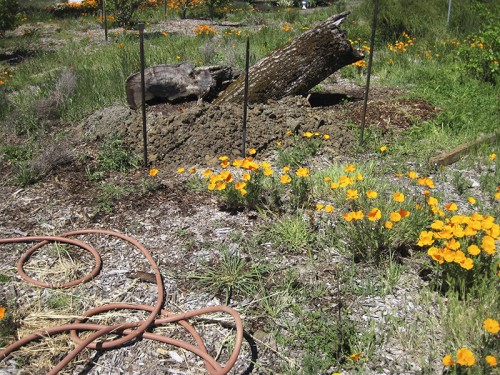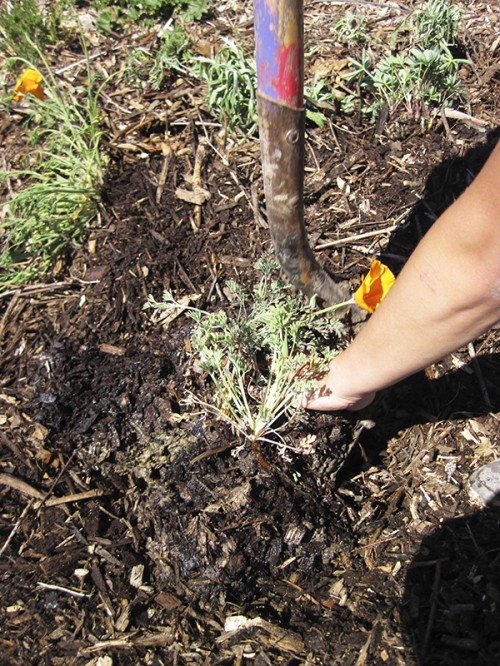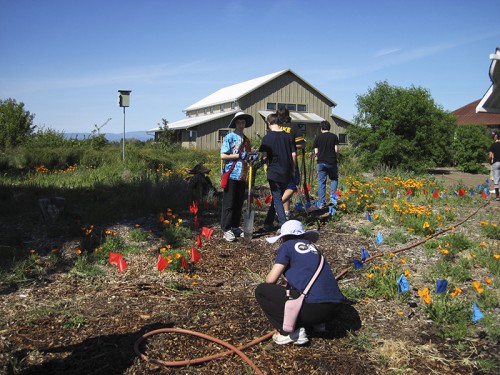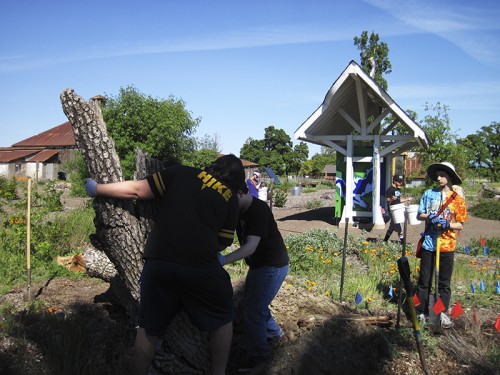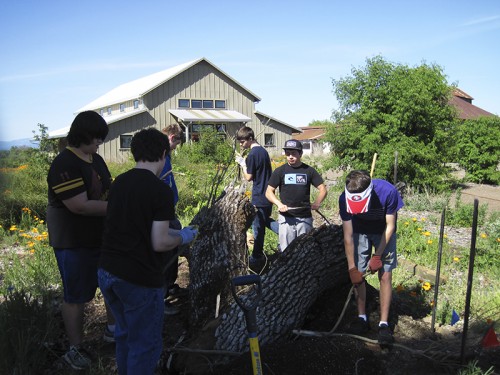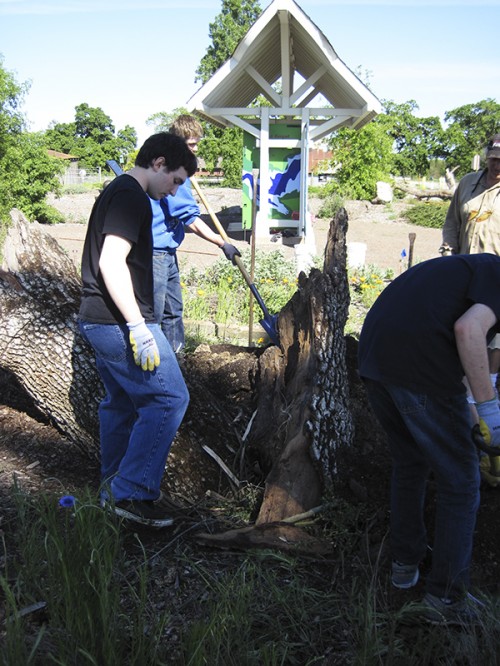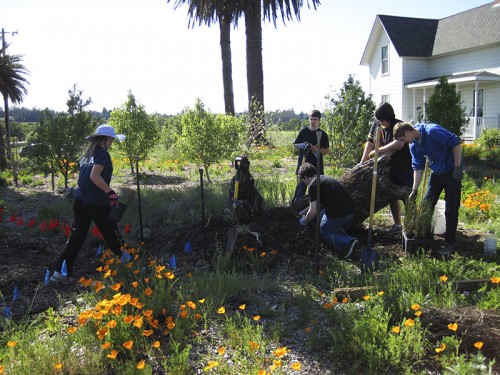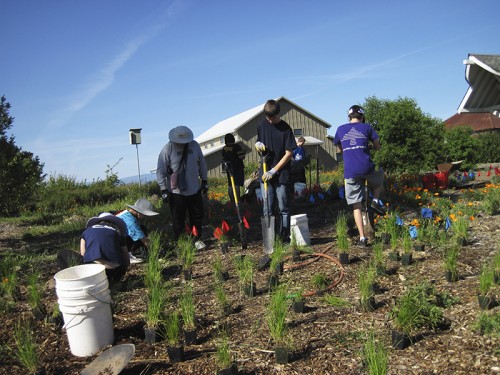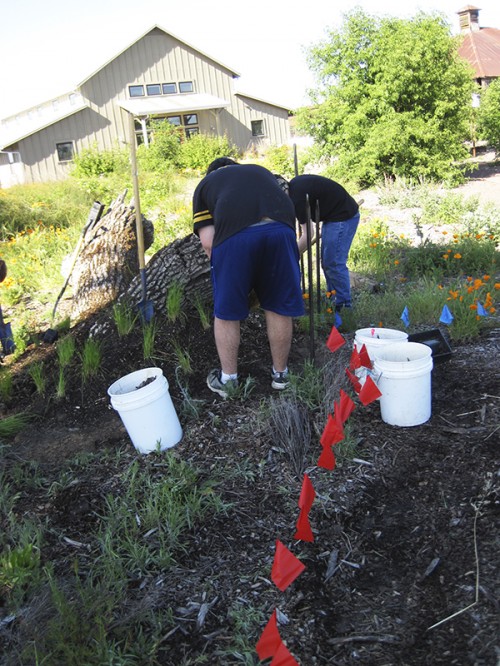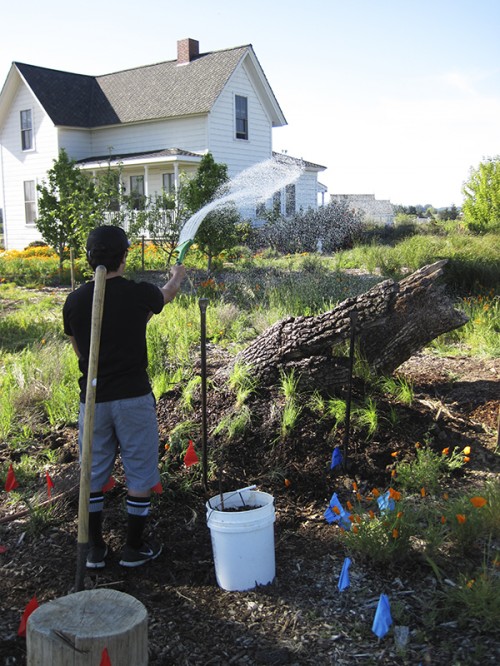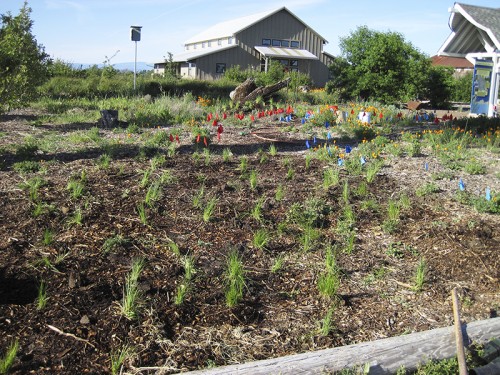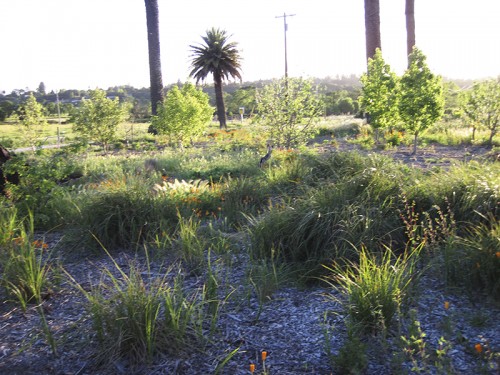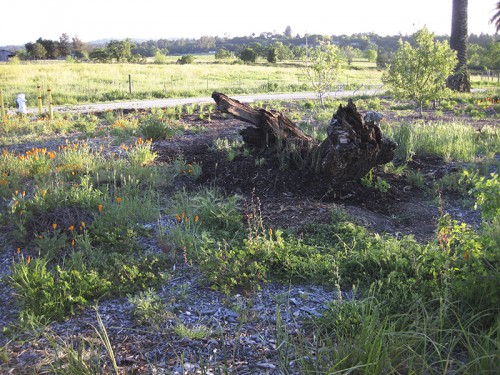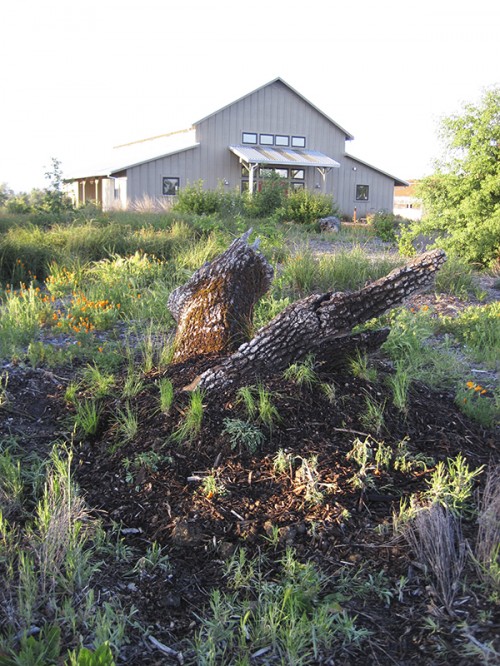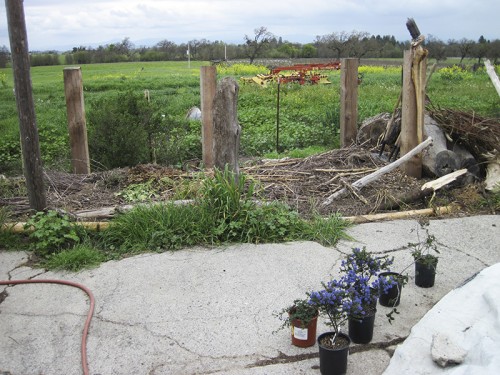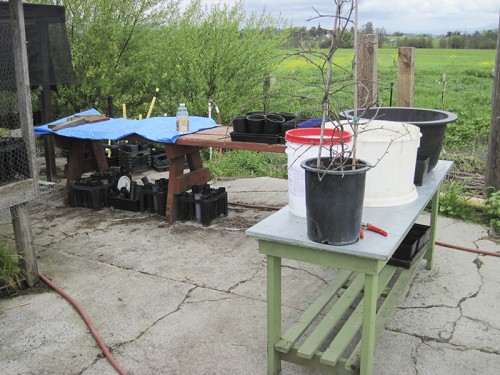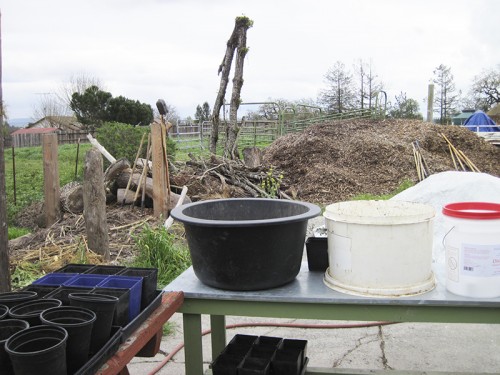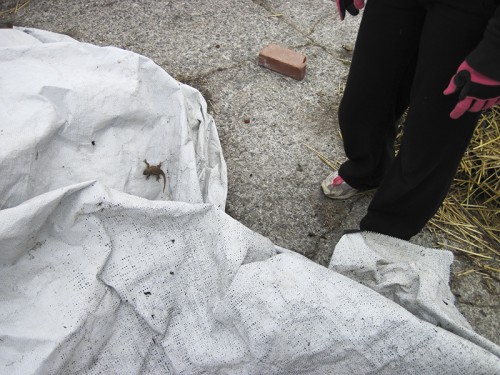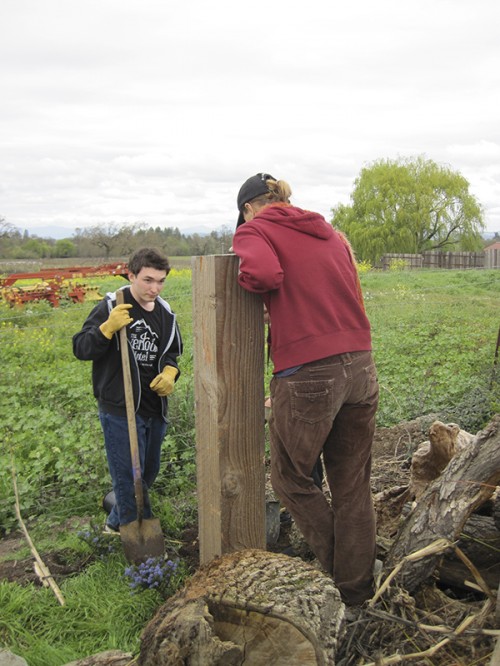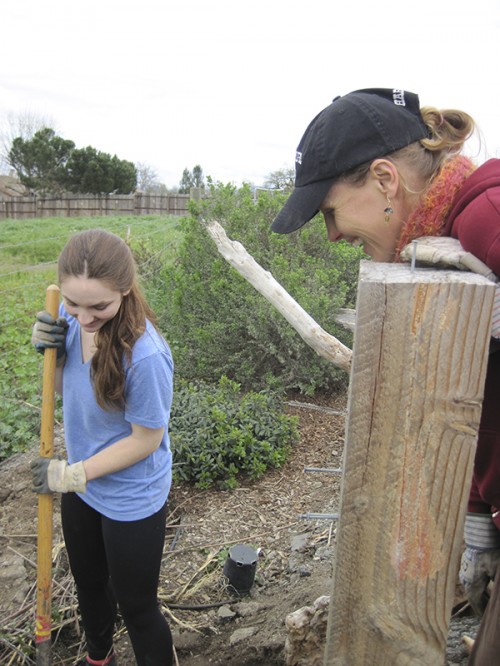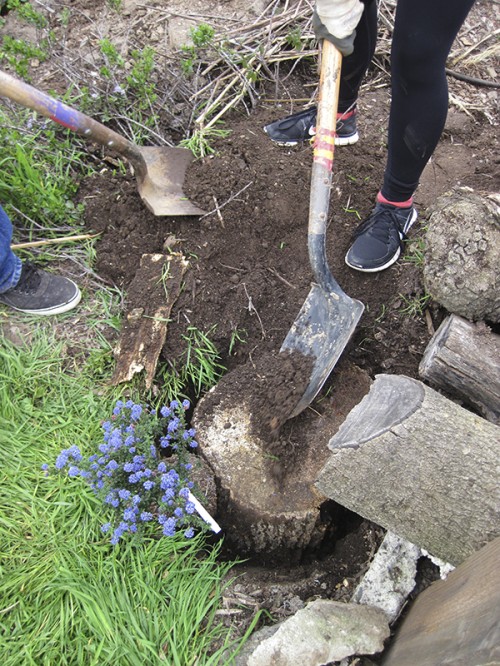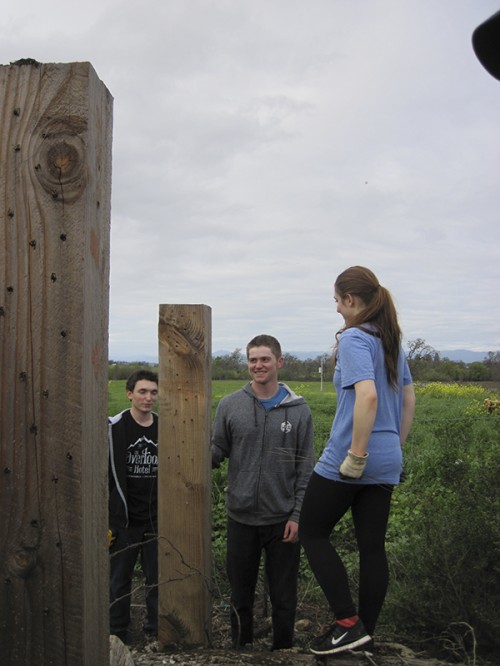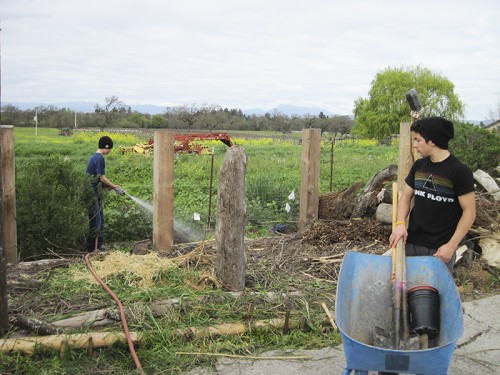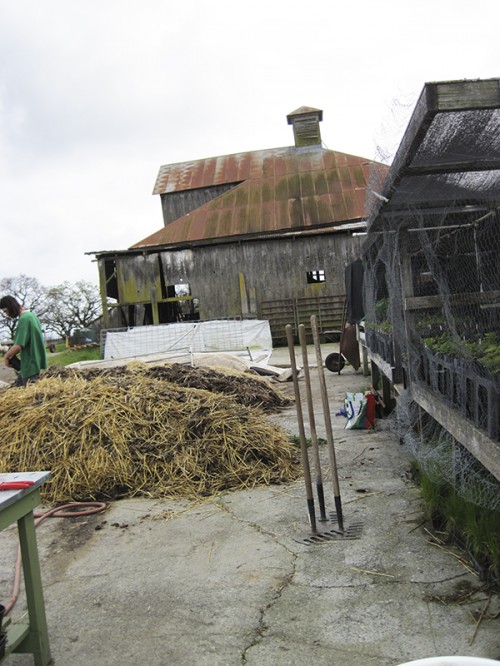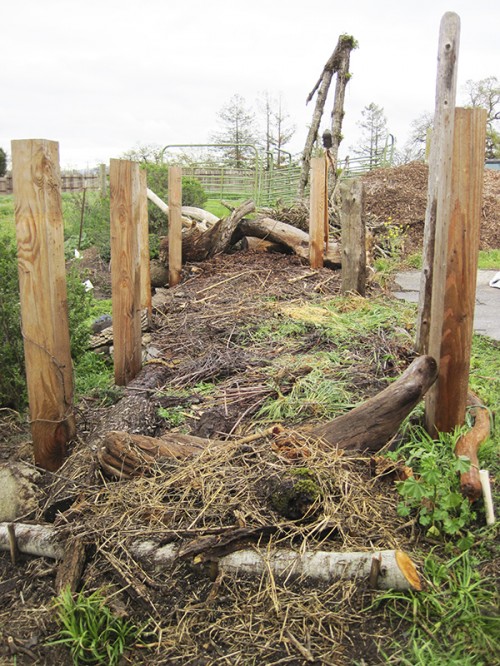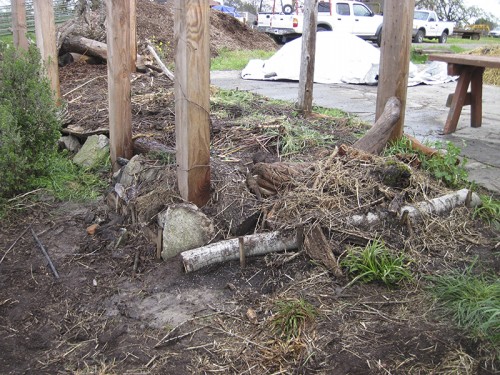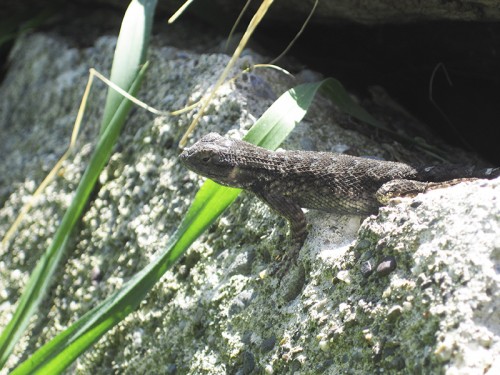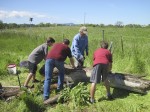
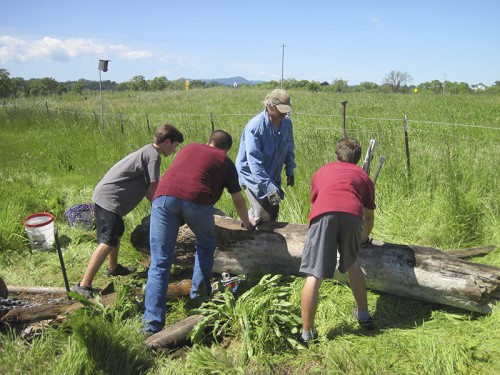 Acorn Launch Pad is an Outdoor Classroom wildlife habitat installation at the Laguna Foundation‘s Laguna Environmental Center, or LEC, located at 900 Sanford Road, Santa Rosa, California, 95401. Date: June 6, 2017. School: Orchard View School, Sebastopol, California. Teacher: Sunny Galbraith. Me: Tony McGuigan, from Spore Lore.
Acorn Launch Pad is an Outdoor Classroom wildlife habitat installation at the Laguna Foundation‘s Laguna Environmental Center, or LEC, located at 900 Sanford Road, Santa Rosa, California, 95401. Date: June 6, 2017. School: Orchard View School, Sebastopol, California. Teacher: Sunny Galbraith. Me: Tony McGuigan, from Spore Lore.
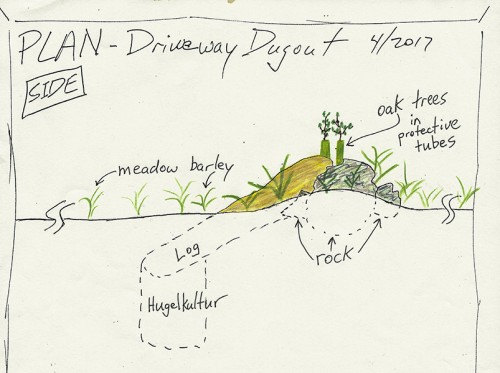 Acorn Launch Pad, hereinafter at times referred to as “ALP” for brevity, is a 3-season wildlife habitat installation. The project evolved during the winter, spring, and summer months of 2016 into 2017. The installation highlight is to plant a valley oak tree between a hubba hubba hulk of a log and a 1000 pound Cold Water Canyon Rock slab. Will the valley oak (Quersus lobata) live to 500 years? Will the tree lift the rock slab as it grows? Not for me to know in 30, 40, 50 years from now, but perhaps the students planting the tree will.
Acorn Launch Pad, hereinafter at times referred to as “ALP” for brevity, is a 3-season wildlife habitat installation. The project evolved during the winter, spring, and summer months of 2016 into 2017. The installation highlight is to plant a valley oak tree between a hubba hubba hulk of a log and a 1000 pound Cold Water Canyon Rock slab. Will the valley oak (Quersus lobata) live to 500 years? Will the tree lift the rock slab as it grows? Not for me to know in 30, 40, 50 years from now, but perhaps the students planting the tree will.
1 Year, 5 Months Before Installation
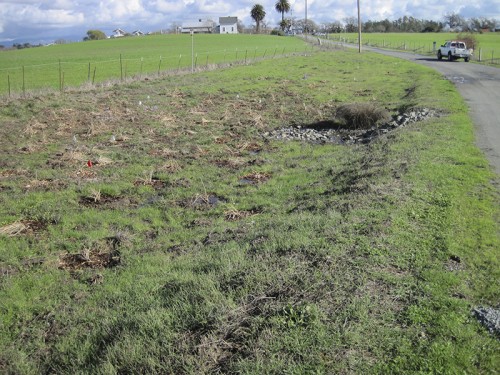 Driveway of Laguna Foundation’s LEC (Laguna Environmental Center), east view. The gate is behind me about 50 feet. Note the rock patch left of the road, at the foot of the culvert pipe, and the juncus rush clump. Juncus (Juncus patens), culvert, and ditch — sounds like water to me! This lower area will make good wildlife habitat, providing habitat’s 4 elements — food, water, shelter, and a place to raise young. Juncus at the site indicates year-round water; the valley oak and critters living in the tree, under the rocks, and in the soil will use that water.
Driveway of Laguna Foundation’s LEC (Laguna Environmental Center), east view. The gate is behind me about 50 feet. Note the rock patch left of the road, at the foot of the culvert pipe, and the juncus rush clump. Juncus (Juncus patens), culvert, and ditch — sounds like water to me! This lower area will make good wildlife habitat, providing habitat’s 4 elements — food, water, shelter, and a place to raise young. Juncus at the site indicates year-round water; the valley oak and critters living in the tree, under the rocks, and in the soil will use that water.
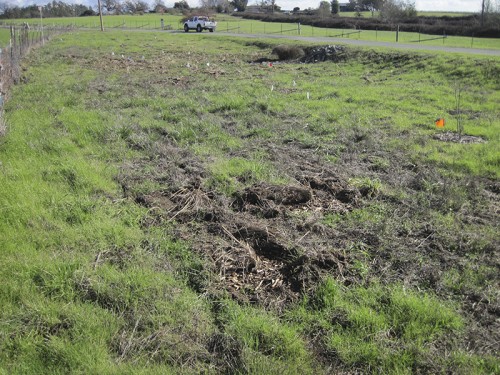 Same view as above pic, but along the fence. Not too early to envision the project; Permaculture principles entail waiting a year (12 months!) before working a site. This winter’s job is to watch the water — how much water from winter floods will fill the site AND where will the water line be?
Same view as above pic, but along the fence. Not too early to envision the project; Permaculture principles entail waiting a year (12 months!) before working a site. This winter’s job is to watch the water — how much water from winter floods will fill the site AND where will the water line be?
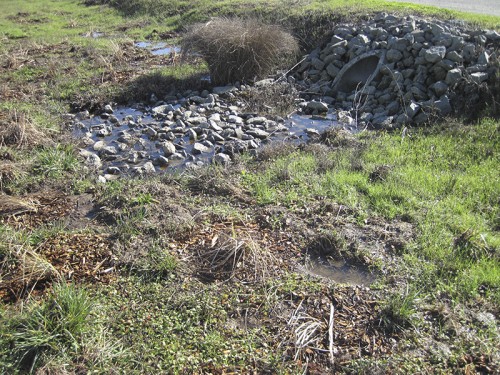 Culvert pipe outlet, north side of driveway, which connects low-lying pastures so the driveway does not flood so quickly. Will take lots of rain to flood over the road. Note how thick (happy) the juncus clump is.
Culvert pipe outlet, north side of driveway, which connects low-lying pastures so the driveway does not flood so quickly. Will take lots of rain to flood over the road. Note how thick (happy) the juncus clump is.
7 Months Before Installation
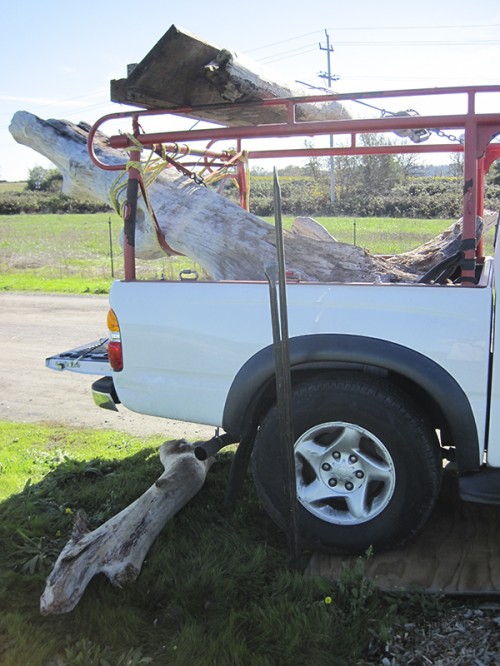 It’s been nearly a year waiting on harvesting wood for Acorn Launch Pad. Last winter’s wet wood (WWW — and nothing virtual about it!) has sunbaked dry, has become lighter. Lighter wood means we can harvest a larger, bulker, hulkier log or tree trunk. Took 4 hours to get Hulk (strapped at angle) into the truck. Note the plywood board under the rear tire — the soft November ground is soft and a tire rut left in the mud would look messy.
It’s been nearly a year waiting on harvesting wood for Acorn Launch Pad. Last winter’s wet wood (WWW — and nothing virtual about it!) has sunbaked dry, has become lighter. Lighter wood means we can harvest a larger, bulker, hulkier log or tree trunk. Took 4 hours to get Hulk (strapped at angle) into the truck. Note the plywood board under the rear tire — the soft November ground is soft and a tire rut left in the mud would look messy.
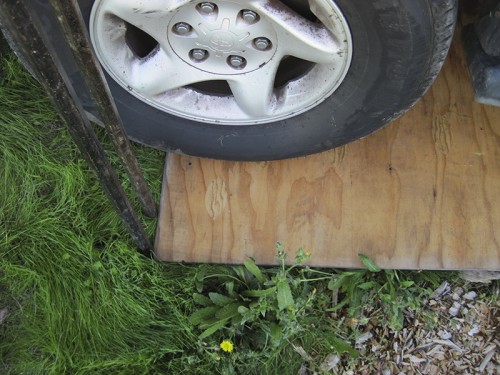 Digging bars keep the plywood in place as the truck’s wheel spins right.
Digging bars keep the plywood in place as the truck’s wheel spins right.
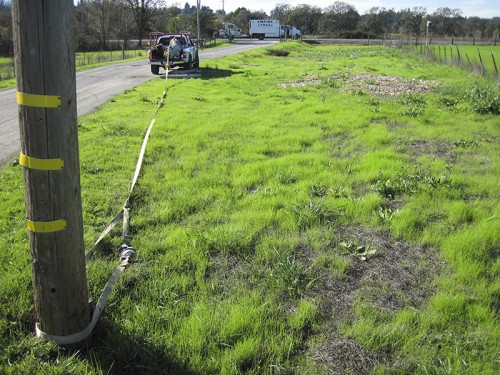 Webbing straps secure Hulk to a perfectly placed telephone pole. Ready?! Set!
Webbing straps secure Hulk to a perfectly placed telephone pole. Ready?! Set!
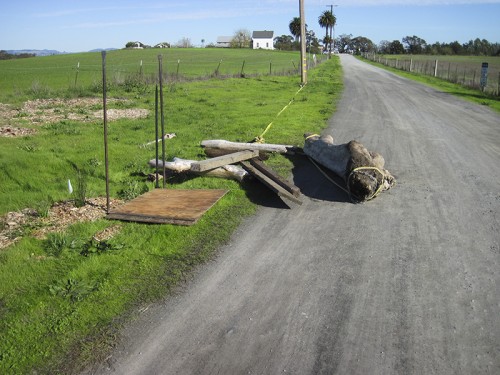 Go!!! Hulk, an oak tree trunk section, arrives home, about 50 feet from the installation site, which is close to the fenceline on the left.
Go!!! Hulk, an oak tree trunk section, arrives home, about 50 feet from the installation site, which is close to the fenceline on the left.
5 Months Before Installation
 So where’s that driveway road? Winter in Sonoma County means water, sometimes flooding. Note how Hulk rests in slightly higher ground above the culvert. Note the lushness of the terrain — hard to imagine that in six months it will be a parched dry golden brown.
So where’s that driveway road? Winter in Sonoma County means water, sometimes flooding. Note how Hulk rests in slightly higher ground above the culvert. Note the lushness of the terrain — hard to imagine that in six months it will be a parched dry golden brown.
 Later that same January 2017 day; the water has risen fast. Yikes! Almost lost Hulk to the flood, but now we know where flood level goes to at the site.
Later that same January 2017 day; the water has risen fast. Yikes! Almost lost Hulk to the flood, but now we know where flood level goes to at the site.
2 Months Before Installation
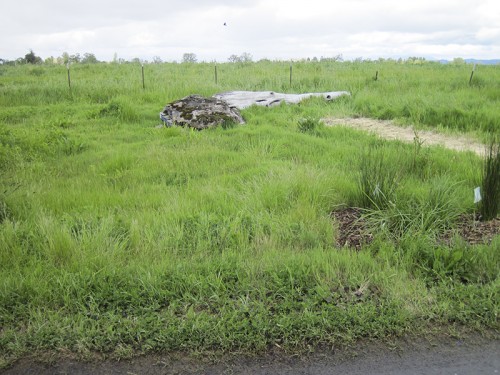 A rock slab is placed on top of 3 smaller landscape boulders. The rock slab, “Rock”, is a 1000 pound (½ ton) Cold Water Canyon (local to Sonoma County) rock. Thank you Stuart Schroeder for the fork lift delivery! The 3 smaller rocks will slow down Rock’s sinking into the soil and will create cavities for critters under Rock.
A rock slab is placed on top of 3 smaller landscape boulders. The rock slab, “Rock”, is a 1000 pound (½ ton) Cold Water Canyon (local to Sonoma County) rock. Thank you Stuart Schroeder for the fork lift delivery! The 3 smaller rocks will slow down Rock’s sinking into the soil and will create cavities for critters under Rock.
Installation Day — Part 1 (6 weeks before Part 2)
 The students from Orchard View School have arrived. Rolling Hulk on its side, we discover . . .
The students from Orchard View School have arrived. Rolling Hulk on its side, we discover . . .
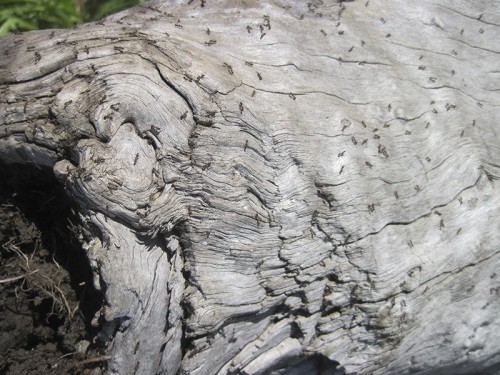 ants! Lots of ants. Busy, swarming red ants, that bite. Obviously, we will be destroying some of their habitat, most likely a nest built under Hulk, as we install another habitat.
ants! Lots of ants. Busy, swarming red ants, that bite. Obviously, we will be destroying some of their habitat, most likely a nest built under Hulk, as we install another habitat.
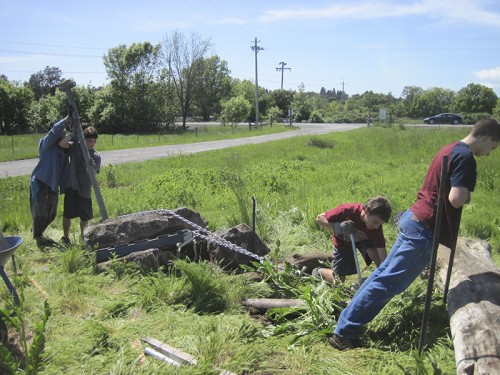 Today’s outdoor classroom project is about mechanical advantage, mostly class 1 leverage. Left, a long metal pipe is toed into the earth and pushed forward, from the top end, to move Rock more centered on top of the 3 landscaping boulders below. A student (second from right) pulls Rock at the same time using a come-a-long. A third student (right) keeps Hulk in place; on the other side of Hulk (far right, out of photo) are digging bars and pipes to anchor the come-a-long. Note that Rock still sits on the fork lift skid/pallet that helped Farmer Stuart deliver it. The wood pallet creates a lot of catching resistance — all the more reason to use mechanical advantage.
Today’s outdoor classroom project is about mechanical advantage, mostly class 1 leverage. Left, a long metal pipe is toed into the earth and pushed forward, from the top end, to move Rock more centered on top of the 3 landscaping boulders below. A student (second from right) pulls Rock at the same time using a come-a-long. A third student (right) keeps Hulk in place; on the other side of Hulk (far right, out of photo) are digging bars and pipes to anchor the come-a-long. Note that Rock still sits on the fork lift skid/pallet that helped Farmer Stuart deliver it. The wood pallet creates a lot of catching resistance — all the more reason to use mechanical advantage.
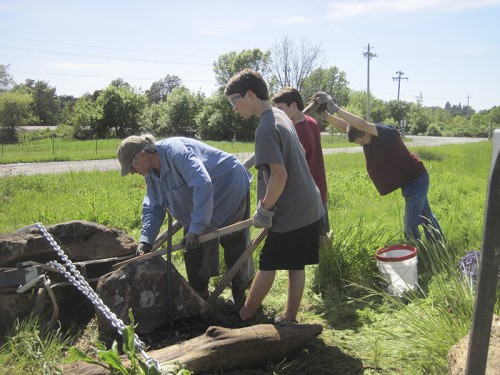 Fine tuning placement of Rock and retrieving the come-a-long chain.
Fine tuning placement of Rock and retrieving the come-a-long chain.
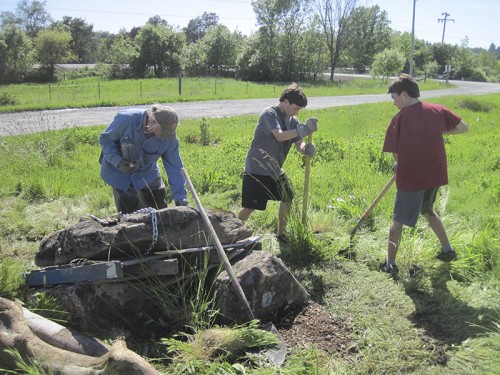 Students begin digging Hulk’s hole, near enough to the rocks so that the tree trunk section will surface and rest on the rocks.
Students begin digging Hulk’s hole, near enough to the rocks so that the tree trunk section will surface and rest on the rocks.
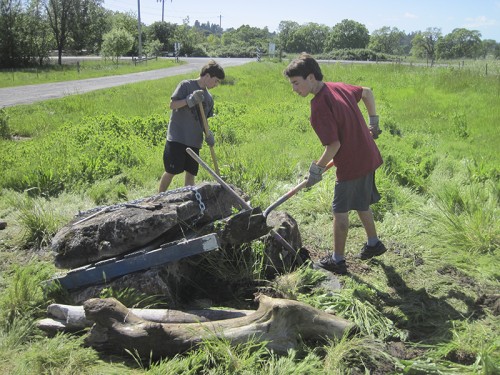 Topsoil and weeds from the hole is thrown into the rock pile to create a rich foundation for planting the valley oak tree.
Topsoil and weeds from the hole is thrown into the rock pile to create a rich foundation for planting the valley oak tree.
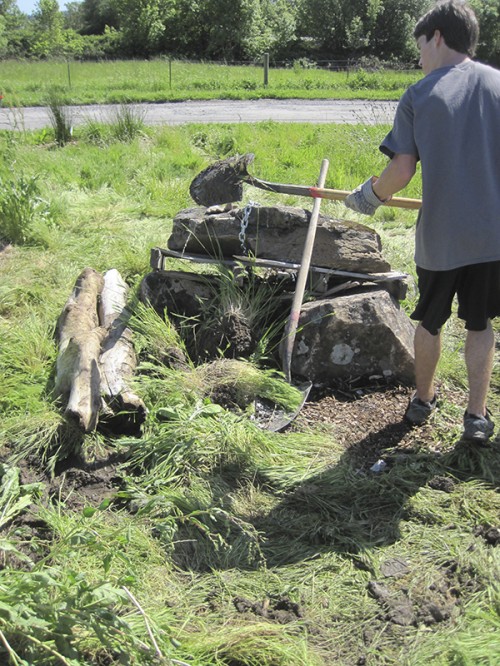 Extra logs are temporarily placed to help create a mound of soil up against the rocks.
Extra logs are temporarily placed to help create a mound of soil up against the rocks.
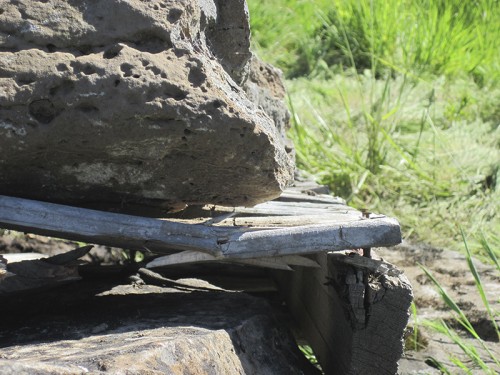 A western fence lizard (tail and foot visible under the pallet) inspects the new Recreation Room.
A western fence lizard (tail and foot visible under the pallet) inspects the new Recreation Room.
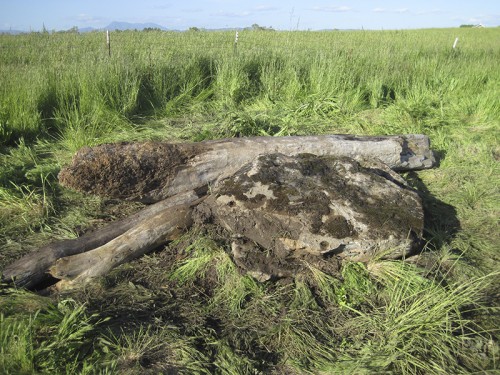 Finished for the day. Acorn Launch Pad waits for the next work session. North view. Note that weeds and mud have been thrown against the rock pile. Also, the extra logs have removed from the soil-mounding area and are now placed into the hole started by the students to alert anyone walking in the field.
Finished for the day. Acorn Launch Pad waits for the next work session. North view. Note that weeds and mud have been thrown against the rock pile. Also, the extra logs have removed from the soil-mounding area and are now placed into the hole started by the students to alert anyone walking in the field.
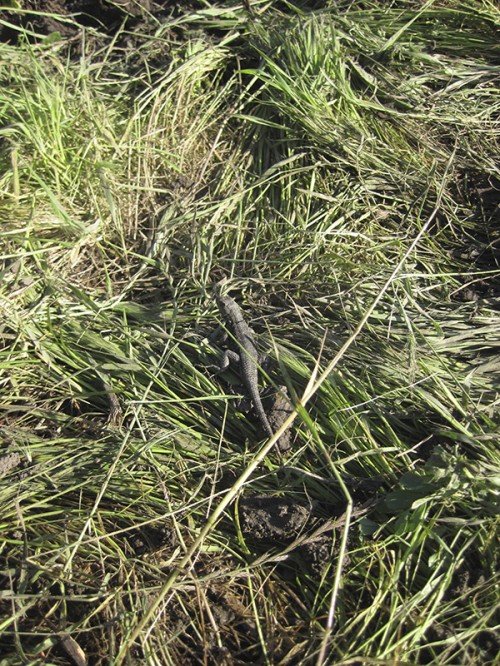 A lizard on its way to the rock pile.
A lizard on its way to the rock pile.
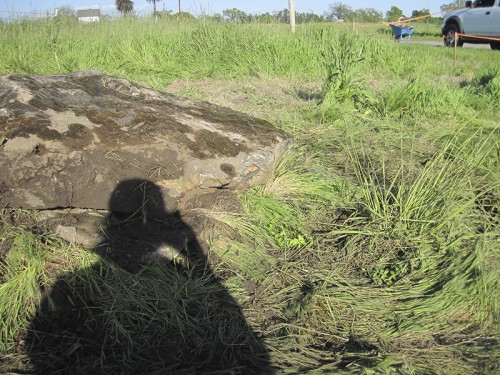 The warm sunny rock has coaxed a lizard out. Notice the little rock alcove it basks in, complete with overhead shelter from predators.
The warm sunny rock has coaxed a lizard out. Notice the little rock alcove it basks in, complete with overhead shelter from predators.
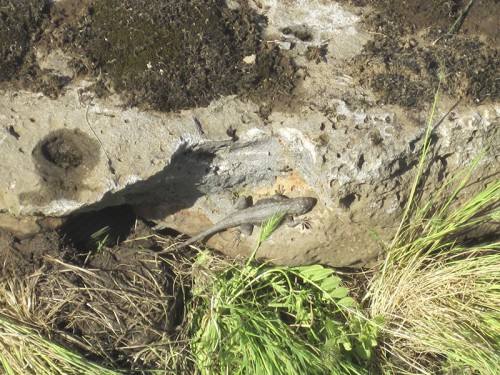 Habitat it and they will come!
Habitat it and they will come!
Installation Day — Part 2 — Completion on June 6, 2017
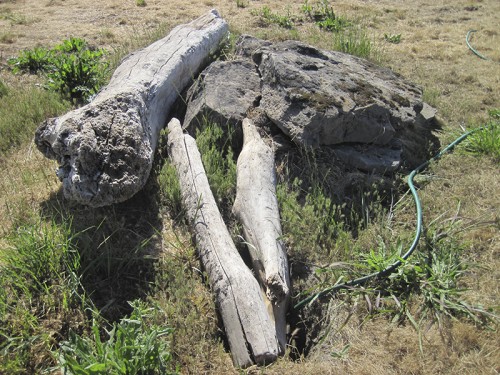 East view. Time to finish this job, 6 weeks later than scheduled. Soft adobe mud has turned into brick hard adobe mud. Today’s job is a different job than it would have been in soft-mud spring. Summer’s heat and dryness have hardened the heavy soil. But we can fix that!
East view. Time to finish this job, 6 weeks later than scheduled. Soft adobe mud has turned into brick hard adobe mud. Today’s job is a different job than it would have been in soft-mud spring. Summer’s heat and dryness have hardened the heavy soil. But we can fix that!
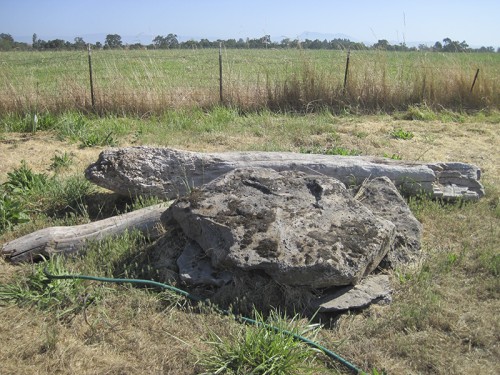 North view. First order of business — get water to the hole so that the soil will soften. A garden hose is stretched out in the sun to warm while tools are gathered. Removing any kinks in the hose now will help increase water flow. Note the dryness of the terrain.
North view. First order of business — get water to the hole so that the soil will soften. A garden hose is stretched out in the sun to warm while tools are gathered. Removing any kinks in the hose now will help increase water flow. Note the dryness of the terrain.
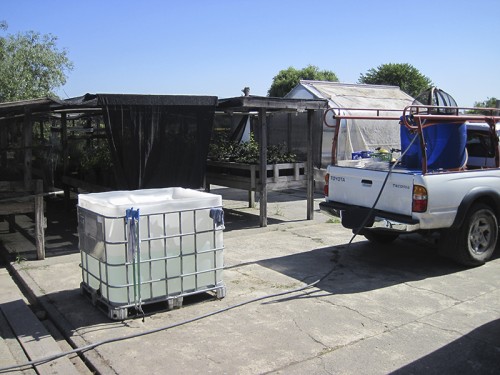 Collecting tools and water from the Laguna Foundation’s Nursery.
Collecting tools and water from the Laguna Foundation’s Nursery.
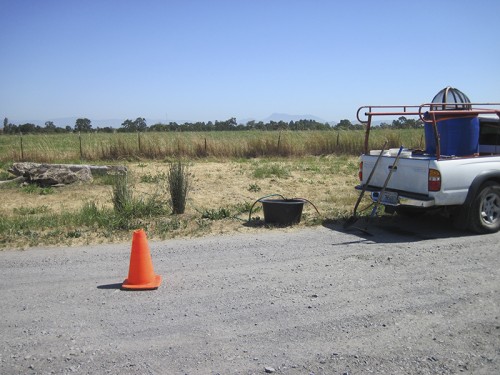 Spore Lore™ Mobile Hydration Station on truck. Hoses deliver water into Hulk’s hole started by students.
Spore Lore™ Mobile Hydration Station on truck. Hoses deliver water into Hulk’s hole started by students.
 Close-up view of getting water to the installation site. The odd-looking dome screen above the barrels is merely to keep the sun-warmed hose from kinking; I ran out of hard pipe to plumb the siphon. 5-gal buckets of water are used to replenish water flowed out of the drums, before the siphon is lost — sure beats carrying the water buckets to the site!
Close-up view of getting water to the installation site. The odd-looking dome screen above the barrels is merely to keep the sun-warmed hose from kinking; I ran out of hard pipe to plumb the siphon. 5-gal buckets of water are used to replenish water flowed out of the drums, before the siphon is lost — sure beats carrying the water buckets to the site!
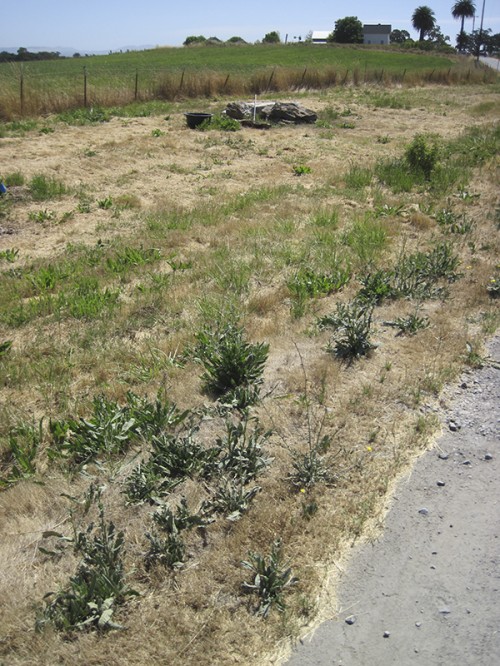 Plenty of time for the hole to be filled with water. Time to take in the beauty of this pasture land, and time to imagine how this habitat might contribute to it. A good time to plan completion of the job, work some art into the finished product. The metal digging bar represents how Hulk is to rest. Catching the eye — visitors to the Laguna Foundation will spot the oak log from afar. Diagonally, and opening away from the road, the log is positioned to welcome visitors. And as for the critters visiting or living in Acorn Launch Pad, they could care less about such artsy stuff.
Plenty of time for the hole to be filled with water. Time to take in the beauty of this pasture land, and time to imagine how this habitat might contribute to it. A good time to plan completion of the job, work some art into the finished product. The metal digging bar represents how Hulk is to rest. Catching the eye — visitors to the Laguna Foundation will spot the oak log from afar. Diagonally, and opening away from the road, the log is positioned to welcome visitors. And as for the critters visiting or living in Acorn Launch Pad, they could care less about such artsy stuff.
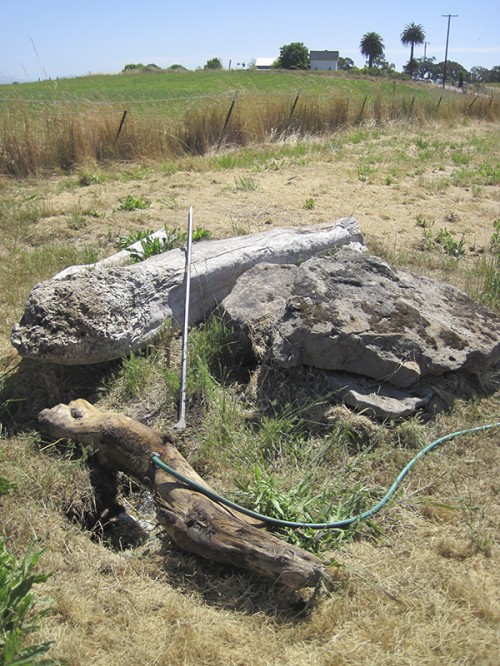 Metal digging bar representing Hulk’s position — close-up view. Hulk and Rock will form a “planting box” for Acorn (the acorns planted to seed the valley oak tree). Fill canyon (trench between Rock and Hulk), plant tree. Simple! Oh, that’s right, no such luck; I’m doing the digging.
Metal digging bar representing Hulk’s position — close-up view. Hulk and Rock will form a “planting box” for Acorn (the acorns planted to seed the valley oak tree). Fill canyon (trench between Rock and Hulk), plant tree. Simple! Oh, that’s right, no such luck; I’m doing the digging.
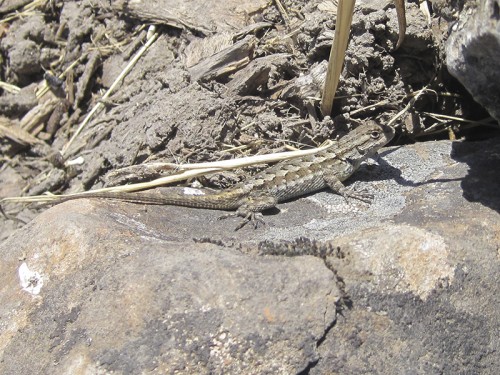 and stops. Perhaps to savor warmth? Perhaps to conceal, not give away so freely, its hideout and/or home. “Who me? I am not here. I have disappeared into camouflage.” Note this camouflage expert’s position. Is it coincidence that this striped animal rests parallel to a like-colored, bleached grass stalk?
and stops. Perhaps to savor warmth? Perhaps to conceal, not give away so freely, its hideout and/or home. “Who me? I am not here. I have disappeared into camouflage.” Note this camouflage expert’s position. Is it coincidence that this striped animal rests parallel to a like-colored, bleached grass stalk?
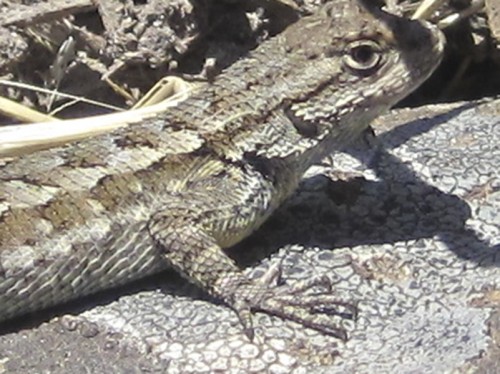 Close-up of western fence lizard entering ALP. Note pattern, color, and texture of Lizard’s right arm. Now do the same for the lichen it has landed on. This guy is good! “Where’s dinner? I heard there were wood beetles, earthworms, and froglets here.”
Close-up of western fence lizard entering ALP. Note pattern, color, and texture of Lizard’s right arm. Now do the same for the lichen it has landed on. This guy is good! “Where’s dinner? I heard there were wood beetles, earthworms, and froglets here.”
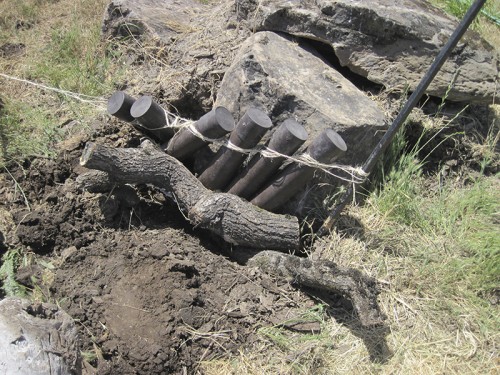 Let’s do the Can Can! Driwater® hydration cans will provide time-released irrigation to young tree roots a year from now. Acorn is set for launch in Fall 2017. Winter rains will help mature the valley oak seedling. Time-released irrigation, using the Driwater® system, will water the seedlings through next late spring and next summer. [No statement here is by Driwater®.] Note the twine line — it was used to keep the cans in place and to “chalk line” surface level. In order words, the twine marks how high the soil will be mounded. Keep in mind that this view of the planting mound is looking through Hulk — Hulk will be installed up against these cans, parallel to them and will form a “planting box”. Note how the cans’ tops have been positioned above soil level. The top will be removed to fill the cans with Driwater® material. Note the oak limbs under and alongside the cans — mycorrhizal fungi trenches in waiting. Those small oak limbs will break down, rot, and become food and homes for soil creatures from today till Acorn is planted. Then, upon planting, the decayed oak limbs will support growth to Acorn through absorbing and holding water and by providing an enhanced mycorrhizal fungi network.
Let’s do the Can Can! Driwater® hydration cans will provide time-released irrigation to young tree roots a year from now. Acorn is set for launch in Fall 2017. Winter rains will help mature the valley oak seedling. Time-released irrigation, using the Driwater® system, will water the seedlings through next late spring and next summer. [No statement here is by Driwater®.] Note the twine line — it was used to keep the cans in place and to “chalk line” surface level. In order words, the twine marks how high the soil will be mounded. Keep in mind that this view of the planting mound is looking through Hulk — Hulk will be installed up against these cans, parallel to them and will form a “planting box”. Note how the cans’ tops have been positioned above soil level. The top will be removed to fill the cans with Driwater® material. Note the oak limbs under and alongside the cans — mycorrhizal fungi trenches in waiting. Those small oak limbs will break down, rot, and become food and homes for soil creatures from today till Acorn is planted. Then, upon planting, the decayed oak limbs will support growth to Acorn through absorbing and holding water and by providing an enhanced mycorrhizal fungi network.
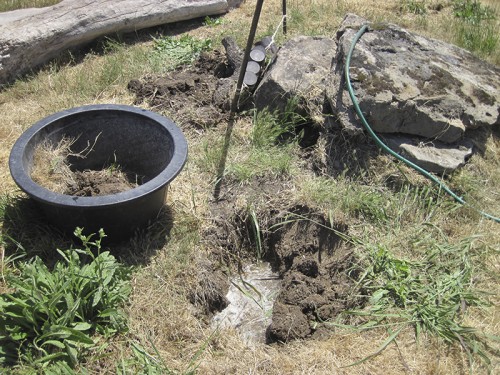 Oak Lake fills while weeds/topsoil are harvested into a storage bin (pond liners are lightweight and strong). The alive weeds/topsoil will be used used to dress Acorn’s adobe hillside.
Oak Lake fills while weeds/topsoil are harvested into a storage bin (pond liners are lightweight and strong). The alive weeds/topsoil will be used used to dress Acorn’s adobe hillside.
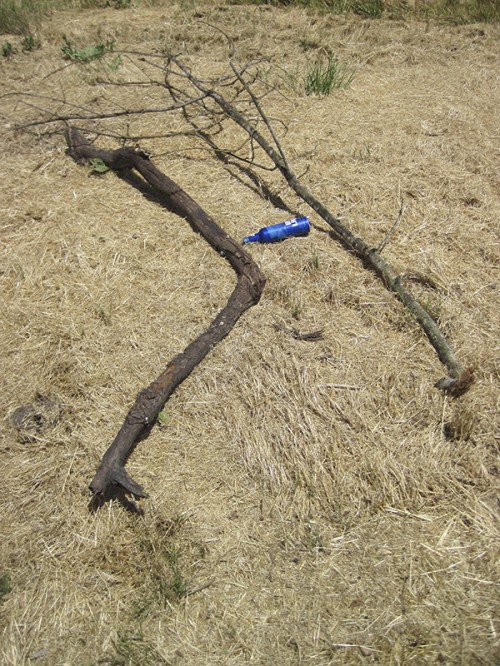 Roadside trash harvested. These old tree branches are good organic material that will come in handy.
Roadside trash harvested. These old tree branches are good organic material that will come in handy.
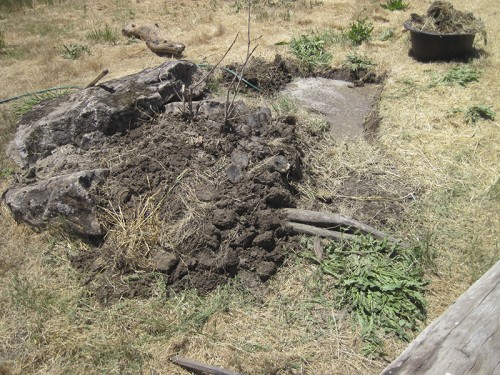 Oak Lake expansion. The water is about 6 inches below grade, just low enough to be contained in the hole and not overfill. Time is the most powerful working agent — the longer the water sits in the hole, the softer the adobe clay becomes. Note the planting of sticks in the center of the soil mound. Those antennae are broken roadside trash branches — wood that will absorb water, break down, and leave a more alive soil for Acorn.
Oak Lake expansion. The water is about 6 inches below grade, just low enough to be contained in the hole and not overfill. Time is the most powerful working agent — the longer the water sits in the hole, the softer the adobe clay becomes. Note the planting of sticks in the center of the soil mound. Those antennae are broken roadside trash branches — wood that will absorb water, break down, and leave a more alive soil for Acorn.
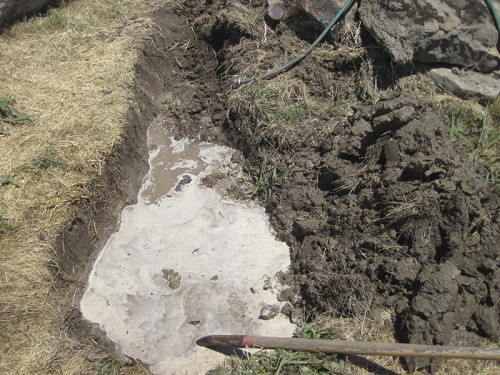 More water. Now the digging is under water, sliver of mud by sliver of mud. Slow digging but doable.
More water. Now the digging is under water, sliver of mud by sliver of mud. Slow digging but doable.
 Hulk flipped into position. Note the closer (foreground) digging bar — it provides our workhorse, leverage, and will pull Hulk to it.
Hulk flipped into position. Note the closer (foreground) digging bar — it provides our workhorse, leverage, and will pull Hulk to it.
 Perfect! Hulk has cleared the end of the hole and can be flipped in.
Perfect! Hulk has cleared the end of the hole and can be flipped in.
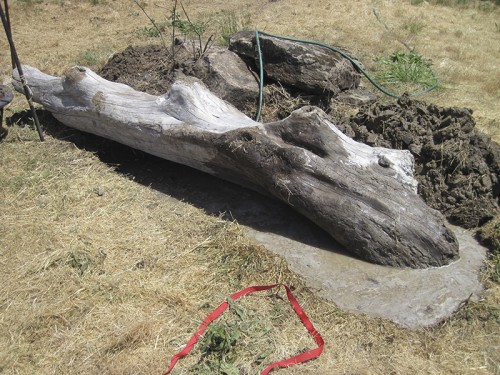 It’s a flawless half turn nose dive! Notice how much more hole there is surrounding Hulk. Hulk will be pulled to the closer shore, toward the red strap. Doing so will allow Hulk to rest parallel with the hydration cans.
It’s a flawless half turn nose dive! Notice how much more hole there is surrounding Hulk. Hulk will be pulled to the closer shore, toward the red strap. Doing so will allow Hulk to rest parallel with the hydration cans.
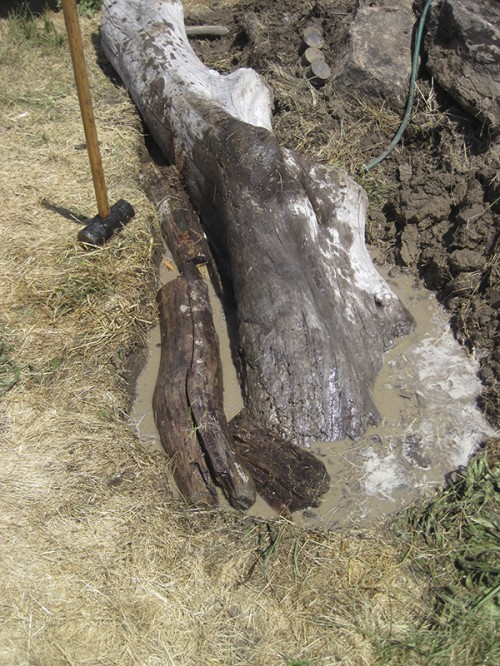 Supporting logs floated in Oak Lake to provide more organic material AND to preserve precious backfill soil. More wood in the hole means less soil needed to fill it.
Supporting logs floated in Oak Lake to provide more organic material AND to preserve precious backfill soil. More wood in the hole means less soil needed to fill it.
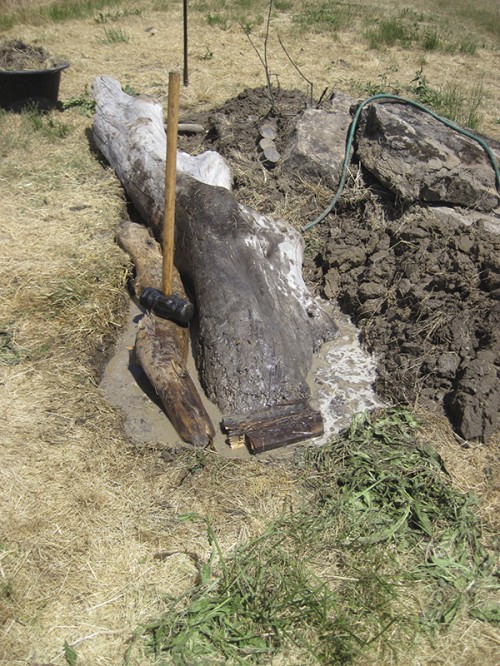 Persuader (sledge hammer) sinks another supporting log next to Hulk. Note that Hulk has twisted on its side. Each flip of Hulk produces a different rainwater collecting surface. Might not sound like much but every drop of rainwater is a big deal to the fungi, flora and fauna that will call Hulk home.
Persuader (sledge hammer) sinks another supporting log next to Hulk. Note that Hulk has twisted on its side. Each flip of Hulk produces a different rainwater collecting surface. Might not sound like much but every drop of rainwater is a big deal to the fungi, flora and fauna that will call Hulk home.
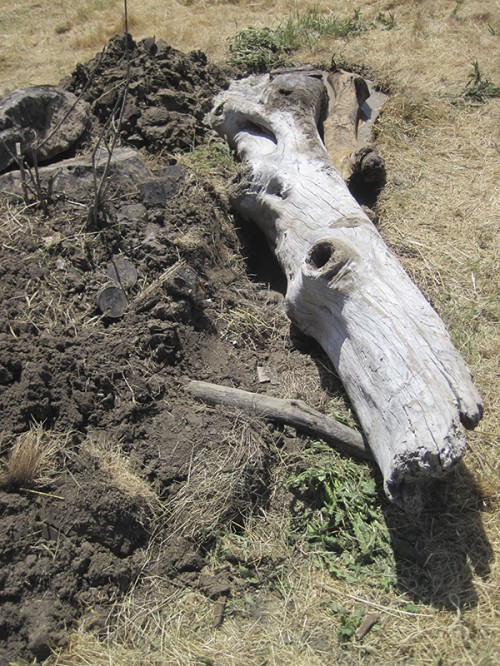 Hulk lays almost parallel to the can line. Half of the adobe mound in the background will line the bottom of the canyon wedge, ensuring that Hulk will absorb water/moisture during rain/fog.
Hulk lays almost parallel to the can line. Half of the adobe mound in the background will line the bottom of the canyon wedge, ensuring that Hulk will absorb water/moisture during rain/fog.
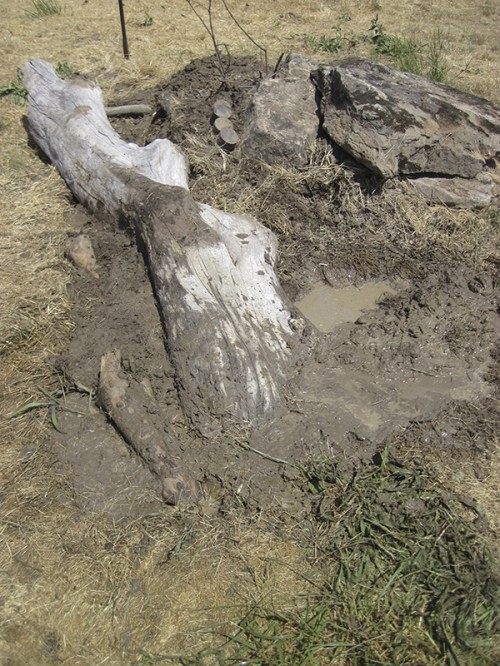 Mudworks. Downhill side of Hulk filled in with Oak Bog (puddle) created to capture rainwater.
Mudworks. Downhill side of Hulk filled in with Oak Bog (puddle) created to capture rainwater.
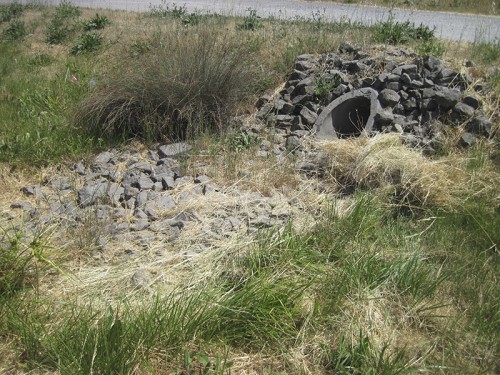 Our old friend, Culvert. A great place to collect straw.
Our old friend, Culvert. A great place to collect straw.
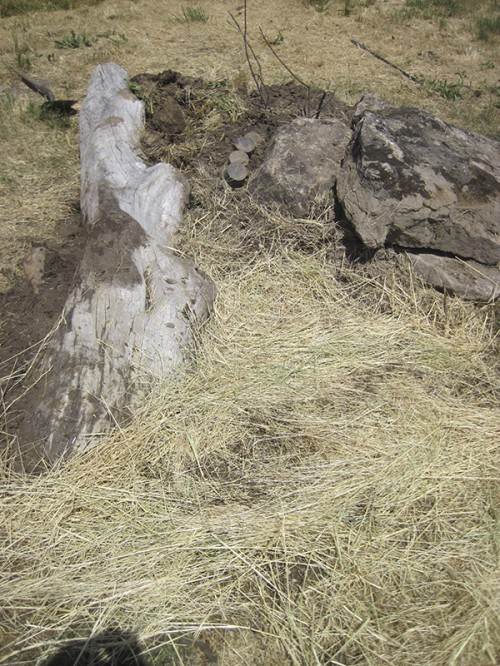 Straw is used to cover the wet mud and to help the habitat blend into local terrain.
Straw is used to cover the wet mud and to help the habitat blend into local terrain.
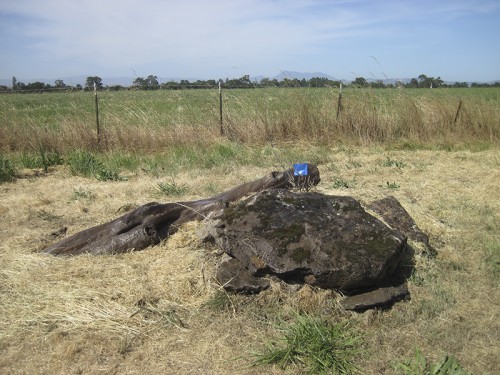 Finished! North view. Acorn Launch Pad wildlife habitat installation is in.
Finished! North view. Acorn Launch Pad wildlife habitat installation is in.
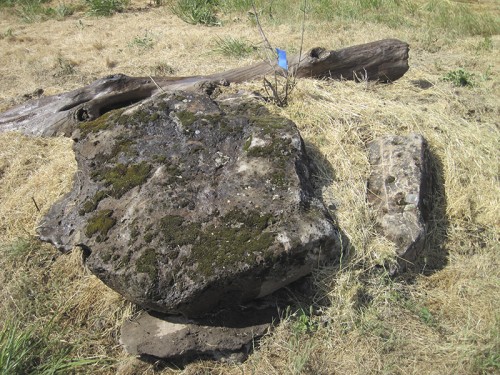 Closer view of finished habitat. Acorn will be planted at the blue flag, between Hulk and Rock.
Closer view of finished habitat. Acorn will be planted at the blue flag, between Hulk and Rock.
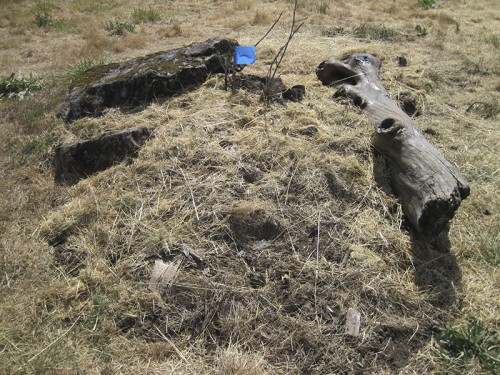 West view of soil mound awaiting Acorn.
West view of soil mound awaiting Acorn.
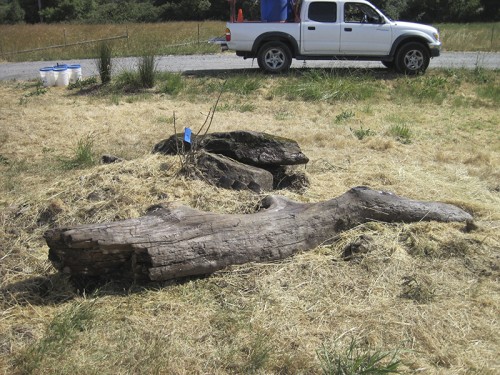 South view. Note that the hydration cans are hidden from road traffic.
South view. Note that the hydration cans are hidden from road traffic.
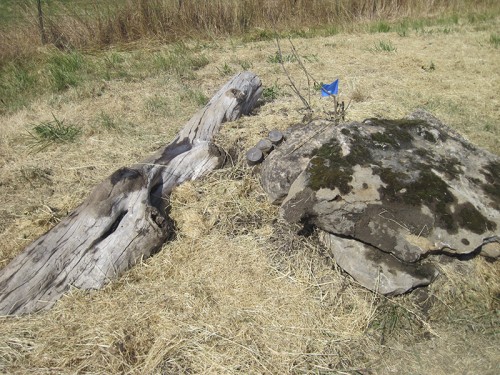 East view. Note that the hydration cans are usable (the lids can be accessed) yet blend into the habitat’s features. The cans will be more hidden in high grass as the habitat fills in with Life.
East view. Note that the hydration cans are usable (the lids can be accessed) yet blend into the habitat’s features. The cans will be more hidden in high grass as the habitat fills in with Life.
See you in the fall to plant (Blast off!!!) Acorn.
Thank you, as always, to Sunny Galbraith, teacher at Orchard View School, Sebastopol, and her students. Also, much thanks to the Staff and Board of the Laguna Foundation, particularly the Restoration and Conservation Science Department: Wendy Trowbridge, Director; Brent Reed, Ecological Program Manager; Sarah Gordon, Conservation Science Program Manager; Paul Weber, Restoration Field Supervisor; Asa Voight, Restoration Technician II; Hannah Werdmuller, Restoration Technician; and Julie Skopal, Nursery Manager.
Enjoy your habitat installations. Habitat it!
Tony

